62 Eclectic Kitchen Design with Natural Textures
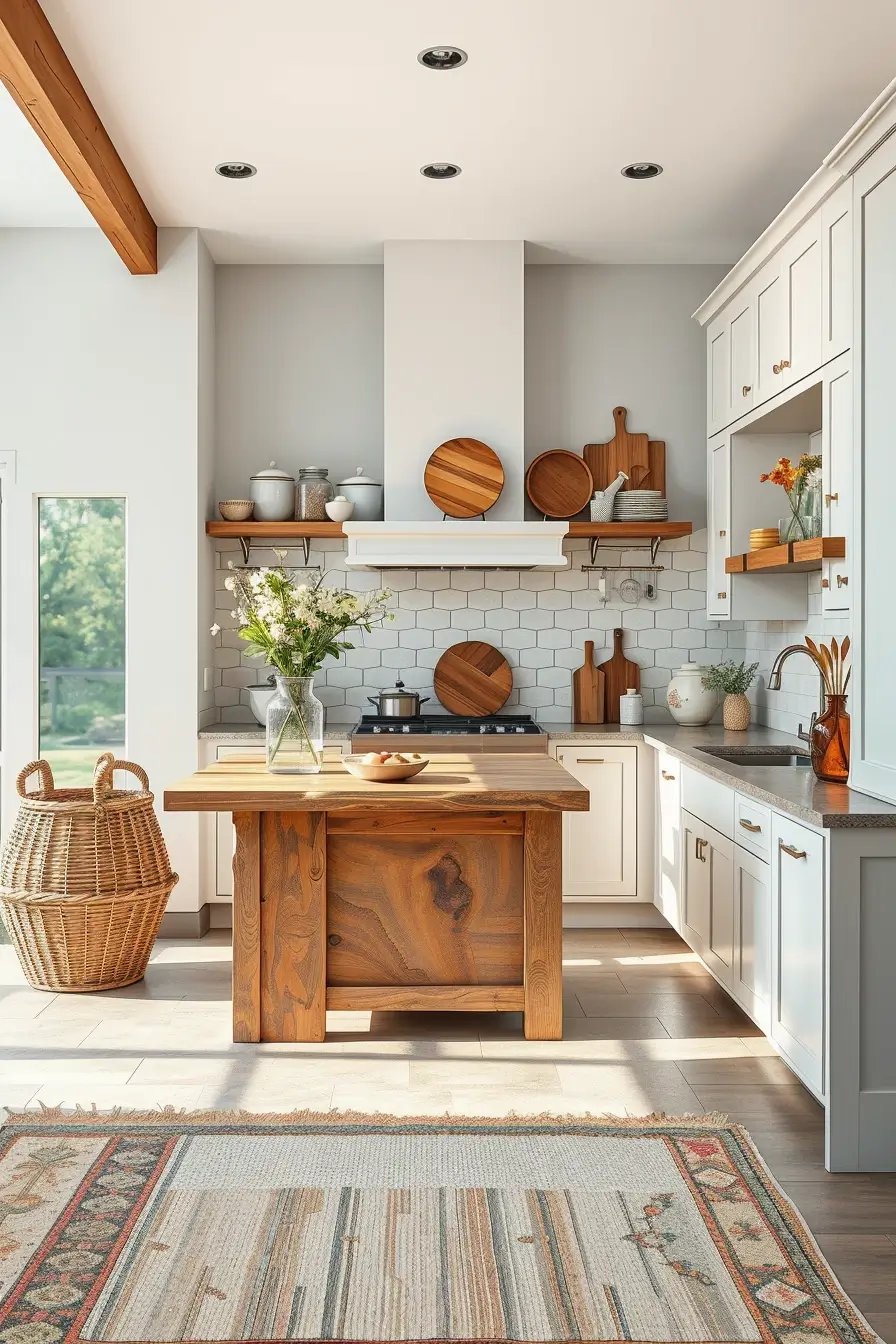
When I consider creating a kitchen I find myself going back to the same question, how do we strike the balance between creativity and comfort? The eclectic kitchen design is the answer. A combination of styles, colors, and finishes allows us to make the space personal and unique. However, it is the natural textures that are the most unifying element–wood, stone, brick, marble, etc. that provide depth, warmth, and authenticity to the core of the home. In this article I will show you how to take eclectic interiors to a higher level with natural textures. We will discuss design, furniture and finishes that will emphasize uniqueness, yet keep the kitchen friendly. Wood accents, concrete details, every section will show how the eclectic style can become a whole and modern space using natural materials.
Whether you are planning a complete remodel or just need some inspiration, I hope to show you how blending textures and styles can transform your kitchen not only into a practical space but also into a truly impressive one. We will immerse ourselves in the beauty of eclectic design and learn how natural beauty can help balance the creative interiors.
The Beauty of Bending Style In The Kitchen
In my case, the best part of an eclectic kitchen design is the liberty it provides to mix opposing styles into one unified whole. I have been working on areas where contemporary cabinets clash with natural finishes and the effect is always impressive. The eclectic design is beautiful because it does not require any rigid guidelines, but rather lets each homeowner design their kitchen to their personality and lifestyle. Natural materials serve as the cement that binds these different elements together, and they form an atmosphere that is not disorganized, but rather gathered.
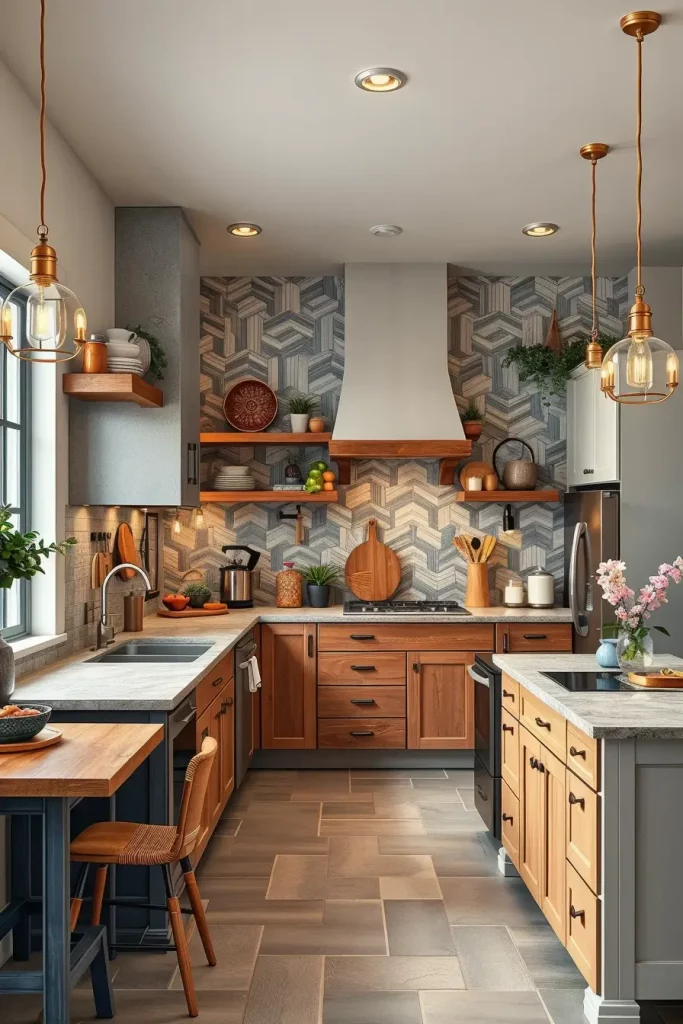
I also ensure that no item is useless when I design such kitchens. A smooth stainless-steel oven may be next to reused wood shelves, and patterned tile backsplashes provide colour on stone countertops. I have witnessed the way this cautious use of textures and materials produces an eternal design. When it comes to furniture, I would recommend that the seating be mismatched i.e. metal barstools and wooden chairs to create uniqueness.
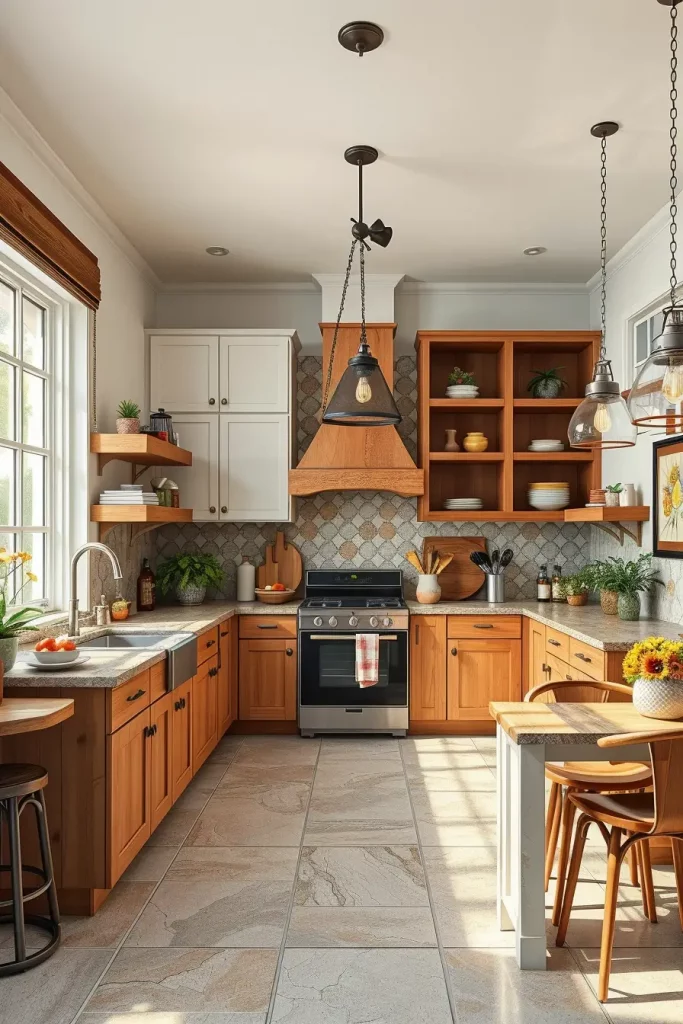
I have found that clients are often concerned that eclecticism can result in visual clutter. I always assure them that so long as there is a source of natural elements such as wood, stone, or marble, the space is grounded. According to design gurus like Architectural Digest, the combination of styles can be very creative, but only when brought together by similar textures. I highly support this point of view.
To narrow this section down, I would add more regarding lighting. Warm-colored pendant lights can unite the blend of textures and styles in eclectic kitchens and make the space look cohesive instead of disjointed.
Why Natural Textures Raise Eclectic Interiors
The role of natural textures in eclectic kitchen design can hardly be overestimated. I have discovered that when a room is too clean or sterile, organic materials instantly transform the environment. Wood, stone or brick add depth, warmth and character. These natural finishes bring the eclectic mix down to earth and make it warm and welcoming rather than intimidating.
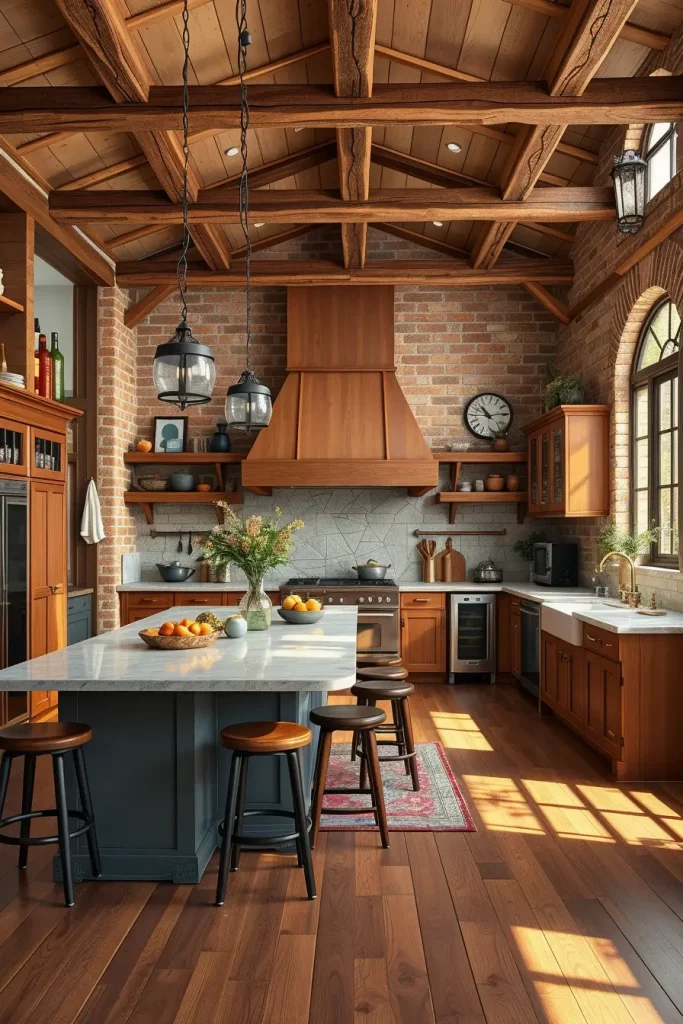
This, in practice, involves working with surfaces and finishes that show their naked beauty. I have used wooden counter tops, bare brick walls or even polished marble islands to take eclectic kitchens to the next level. All these features narrate a story and counterbalance the daringness of the mismatched colors or different cabinetry. In the absence of these textures, eclectic spaces will be artificial or out of place.
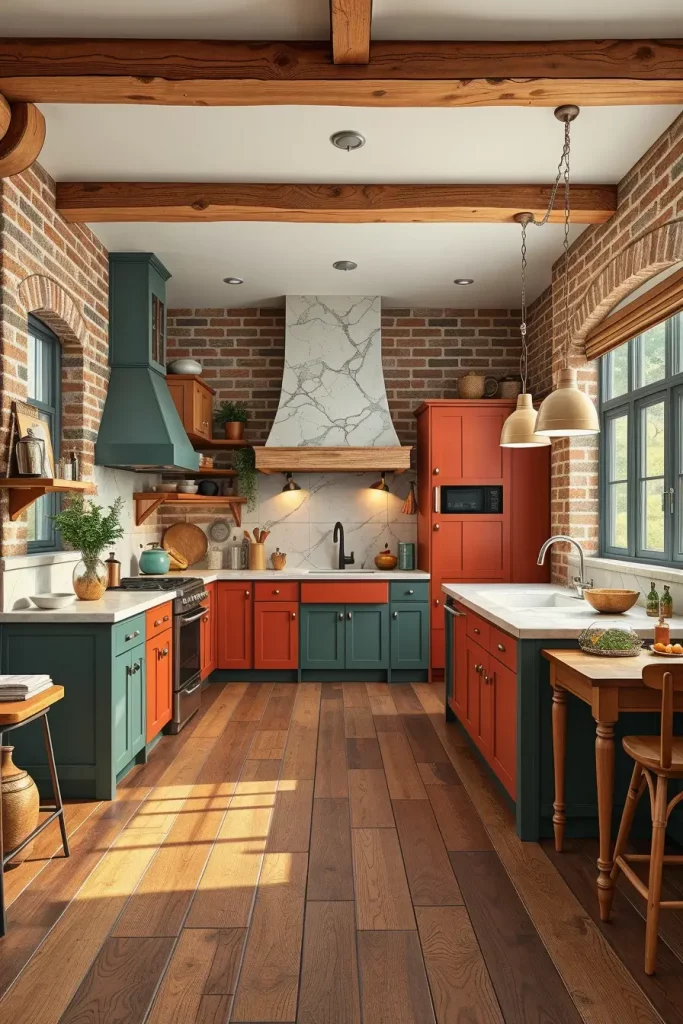
On a personal level, I am moved by the feel of natural textures. As House Beautiful notes, the most daring designs are still helped by grounding details that render a space timeless. I tend to repeat this recommendation to customers who are attracted to bright colors or unusual items–they are brighter when they are placed against the natural beauty.
Had I time to enlarge, I should mention the significance of flooring. Hardwood or stone flooring will not only add the organic touch but will also unify the kitchen and give other eclectic features something to play off.
Wood Accents That Define The Eclectic Kitchen
Wood is the most versatile material in kitchen design and in an eclectic kitchen, it is vital. I prefer the use of wood accents as they tend to tame bold designs and make them more friendly. Warmth is introduced by natural wood colors, whether on flooring, cabinetry or shelving. They can fit any combination of styles, and thus they are the ideal component to counterbalance the colorful character of an eclectic interior.
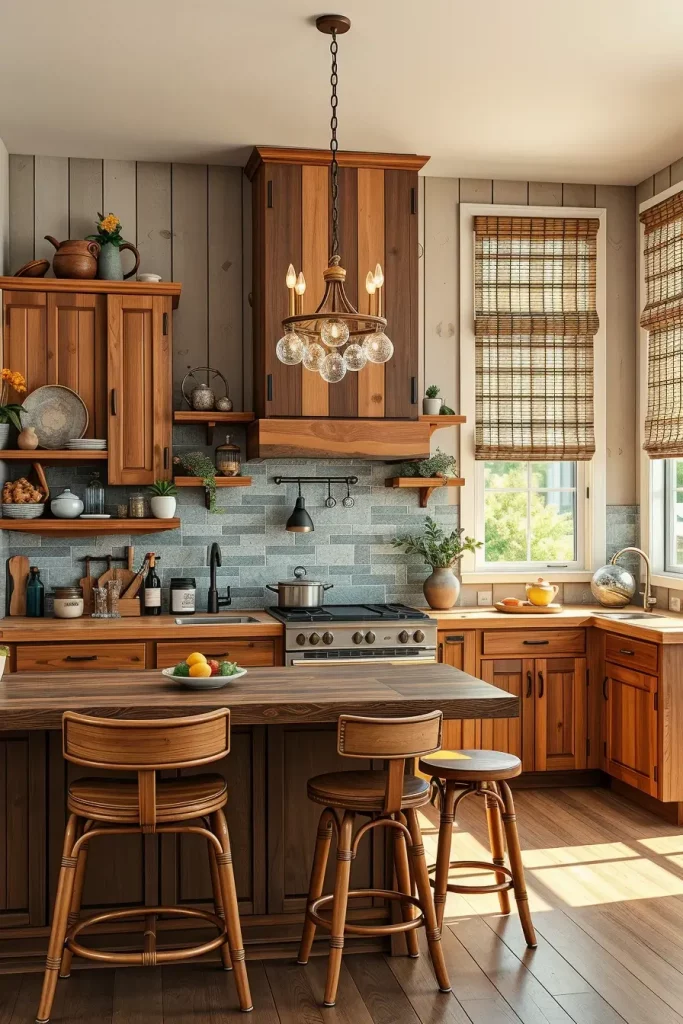
In my work with clients, I tend to use wood in the form of cabinetry with natural finishes, reclaimed wood shelves, or even butcher block countertops. Wooden furniture such as dining chairs or barstools may provide an additional touch of natural beauty. The combination of wood species like oak, walnut, or pine provides me with a stratified appearance that is not too artificial.
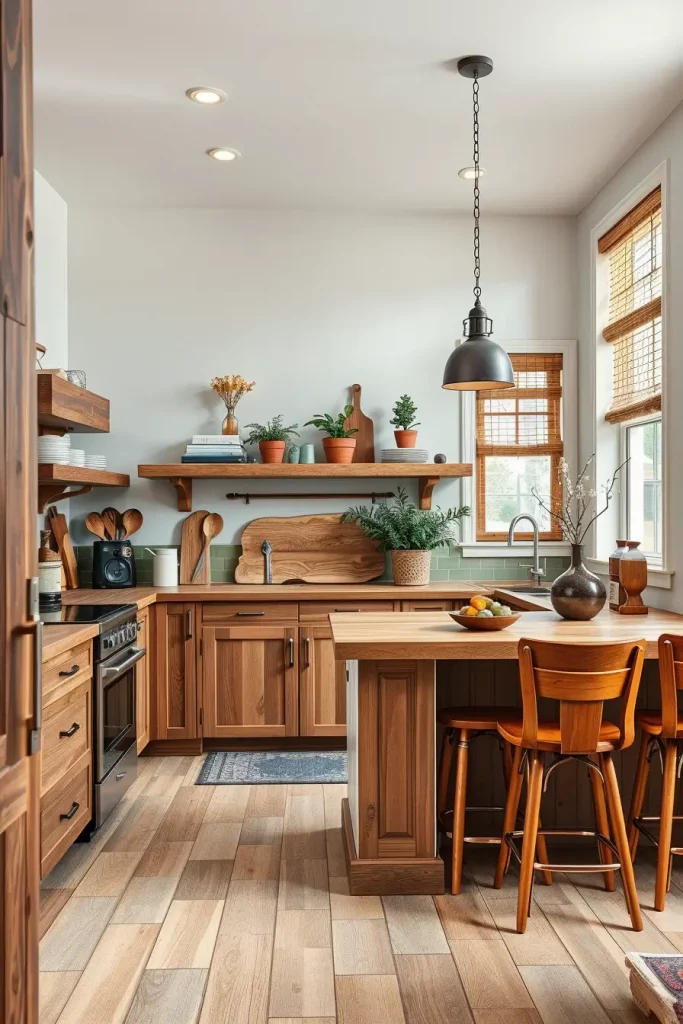
In my opinion, the most important success factor is restraint. Excessive wood may obscure the design and the appropriate balance will add contrast to stone, metal or marble. According to the experts at Elle Decor, wood must be used as a grounding texture, and it should not be in competition with eclectic items. I have personally experienced the difference that even a minor addition such as wooden trim on cabinetry makes.
I think that this part can be reinforced by adding woven wood, such as rattan barstools or bamboo blinds. They continue the natural theme and provide texture which goes well with the eclectic style.
Stone Surfaces For Organic Character
Stone provides permanence and stability to eclectic kitchens. I have always liked the way stone surfaces such as granite or limestone instantly provide an organic quality. Their uneven lines and down-to-earth sounds offset the playful mix of eclectic interiors. In addition to being beautiful, stone is a strong material and can be used as countertops, backsplashes or flooring.
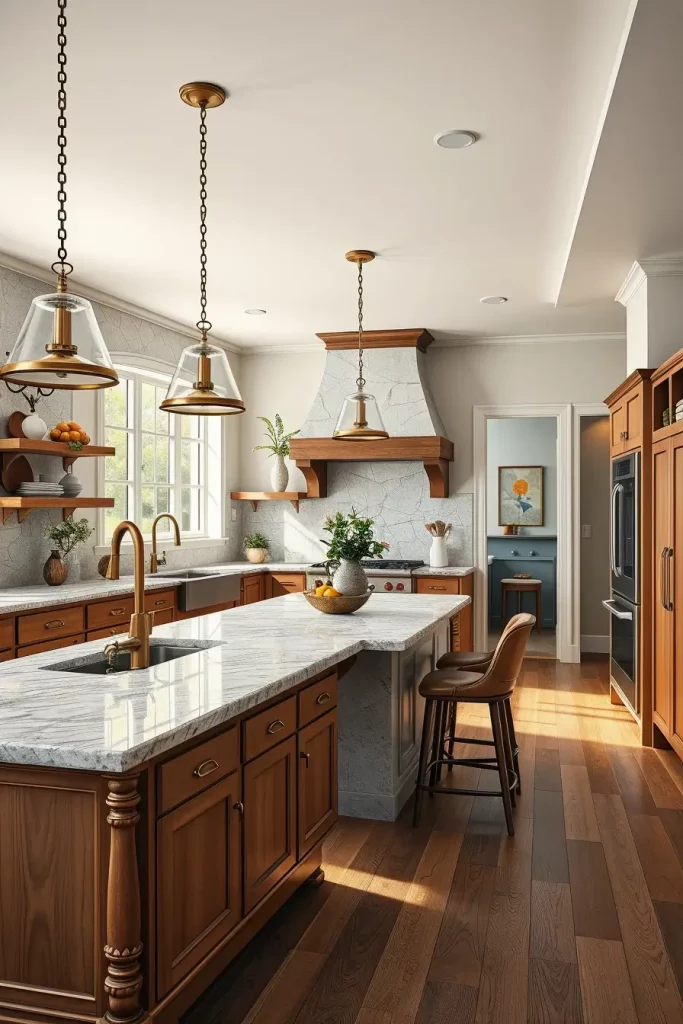
I tend to use stone islands or countertops in my designs as a contrast to bold cabinetry. Stone back splashes, rough cut or polished are a point of focus without consuming excessive space. A stone wall can transform the mood of a kitchen even with just one stone wall, making the environment grounded.
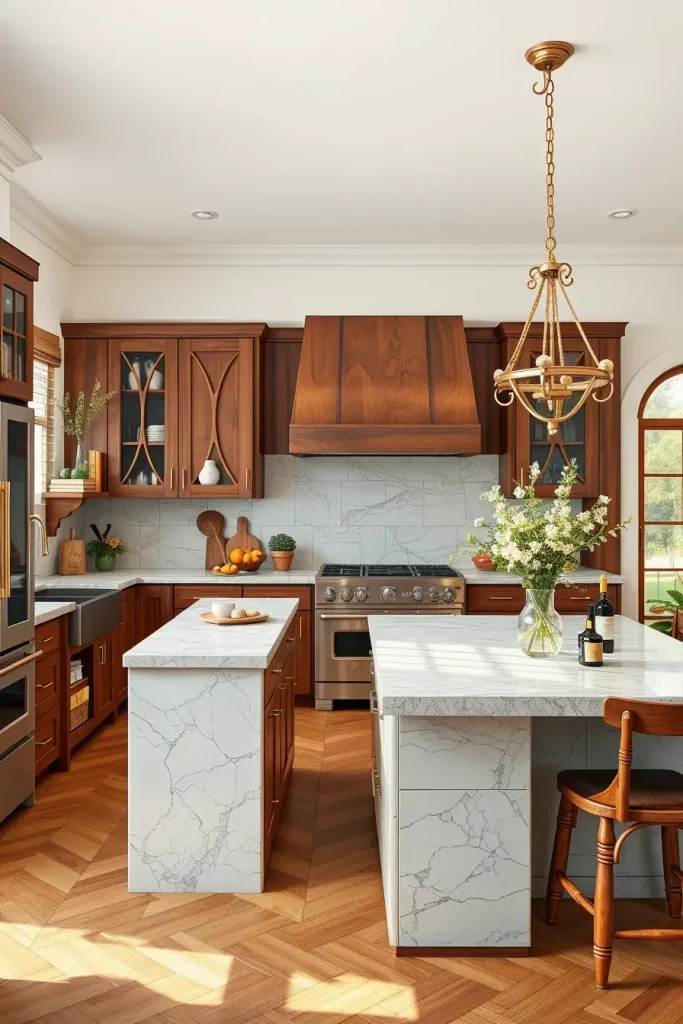
I personally get inspired by stone surfaces as they make the outdoors indoors. The feel of natural stone makes it more comfortable and three-dimensional, regardless of the diversity of the design around it, as Better Homes & Gardens frequently emphasizes. In my opinion, eclectic kitchens are based on contrasts, and stone surfaces are one of the most effective instruments to attain this balance.
To reinforce this concept, I would recommend using stone with warm metals such as brass or copper. This provides visual contrast and makes the eclectic design look intentional instead of unintentional.
Brick Walls As A Rustic Eclectic Statement
One of my favorite design elements in eclectic kitchens is always exposed brick walls. They add immediate texture and coziness and make the room look rustic but still letting modern or traditional elements shine through. Brick is a rough material that contrasts with smooth marble or smooth stainless steel, which is why it is a key element of eclectic interiors.
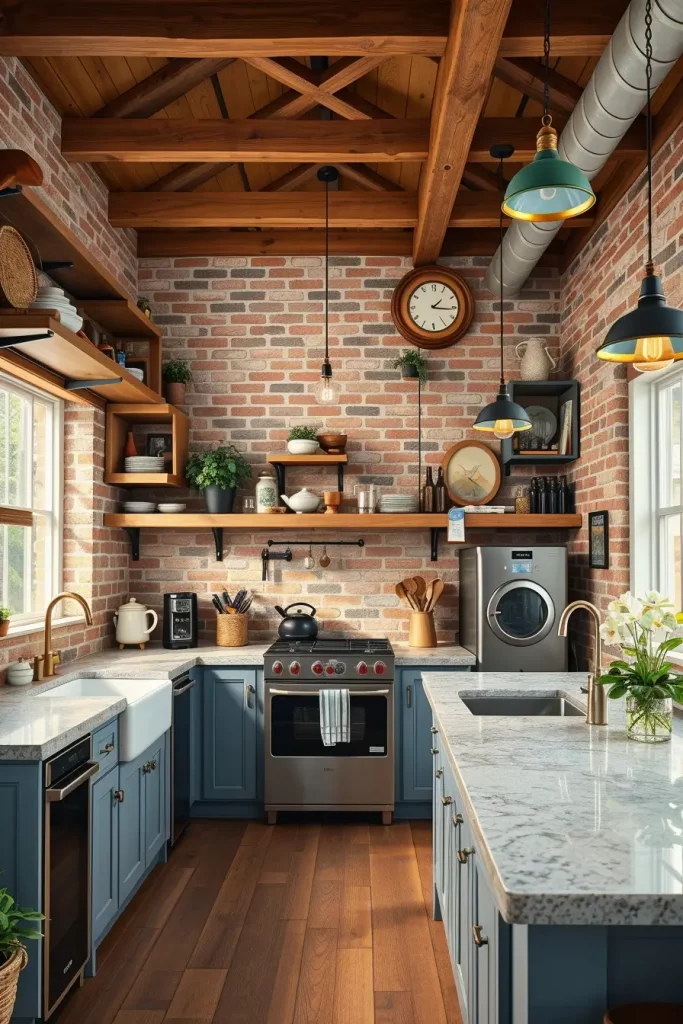
I usually combine brick with wooden shelves, open cabinets, or stone countertops when I incorporate it in a design. The combination emphasizes the earthiness of the brick and allows other textures to shine. Another perfect choice is painted brick that looks less sharp but still has the depth and character of the material.
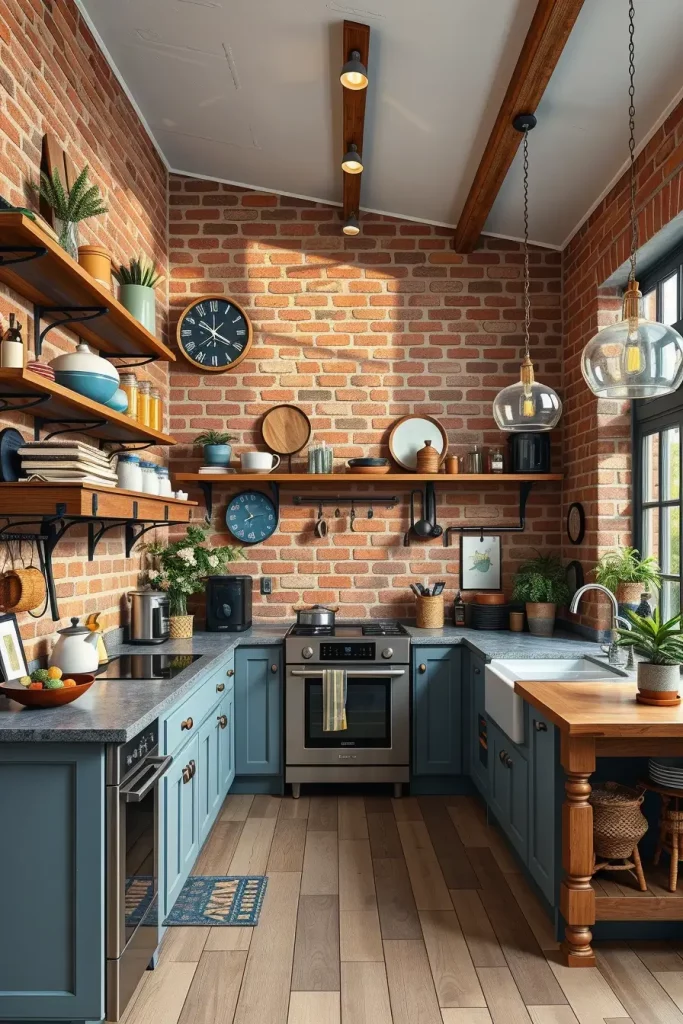
Brick walls instantly make a space seem real in my experience. Brick is also recommended by many design experts like those at Apartment Therapy because it serves as a backdrop and a focal point. I have observed clients become in love with the personality brick that is added even when it is sparingly used.
Here I would suggest some light information. Pendant lights of industrial style or warm under-shelf lighting on a brick wall emphasize the texture of it and reveal all its beauty.
Marble Countertops With A Natural Twist
Marble countertops are a traditional option, however, in eclectic kitchens, they acquire a different existence. I like the way the veining in marble forms natural art that contrasts with eclectic cabinetry or colored tiles. Marble is sophisticated but organic, which makes it an all-purpose anchor in these creative interiors.
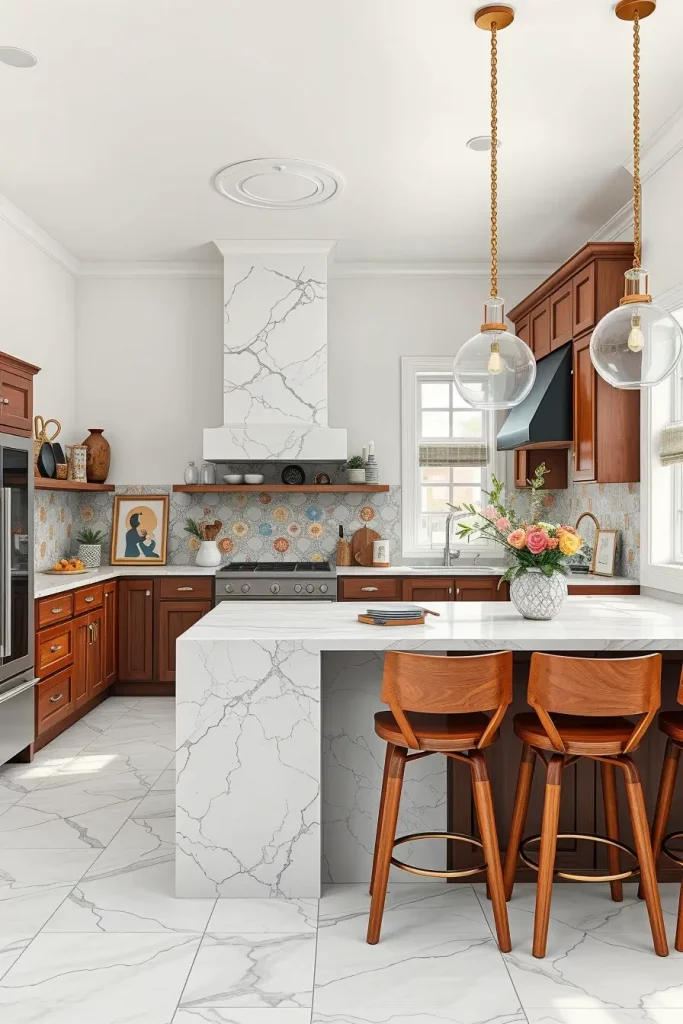
I tend to include marble islands as a focal point, combined with wooden cabinetry or brick walls. The kitchen is elegant and playful when combined with marble and reclaimed wood barstools or bold shelving. Another characteristic of marble is that it is also a durable material, meaning it is not merely a cosmetic feature, but can be used in everyday cooking and entertainment.
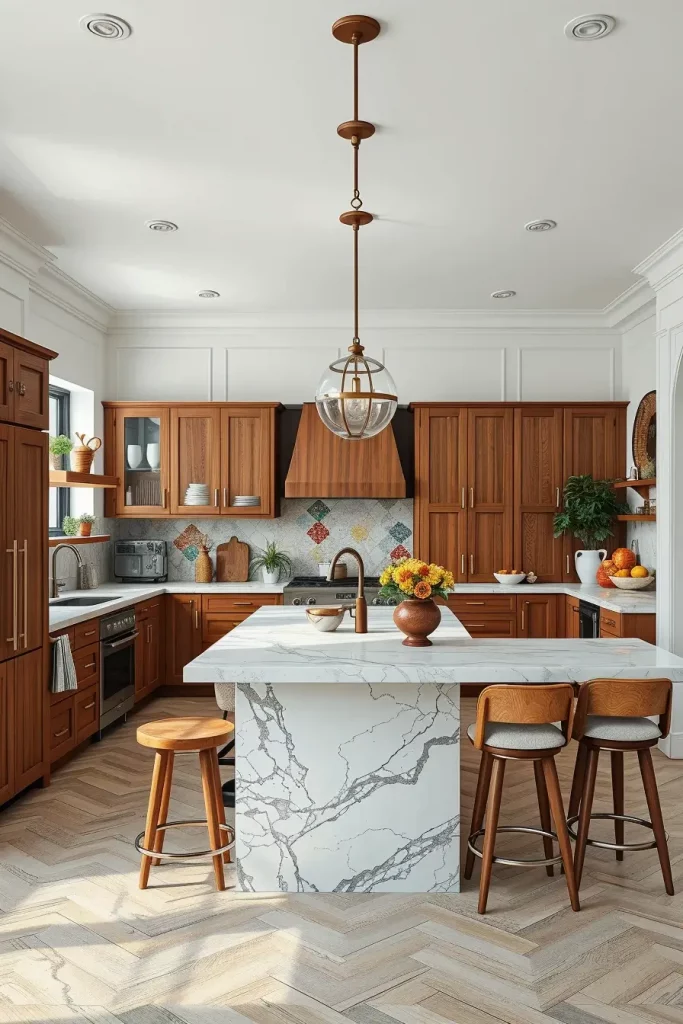
In my opinion, marble creates balance to eclectic spaces. According to Domino Magazine, marble is classic and yet versatile enough to fit contemporary, rustic or traditional combinations. I find marble is always the solution when the client desires something that is polished and yet not sterile.
I believe that accessories could be mentioned in this section. Marble cutting boards, trays or backsplashes continue the theme without crowding the space, and the eclectic design is more unified.
Hardly Finished Details To Contemporary Eclectic Style
Concrete is not the first material that people consider when thinking of eclectic kitchens, but I have discovered that it gives it a modern touch that perfectly matches the style. Its austere, cold surface is contrasted with the richness of the wood or brick, producing a stratified appearance that is not accidental. Concrete is flexible, strong, and unexpectedly cozy when combined with the appropriate accents.
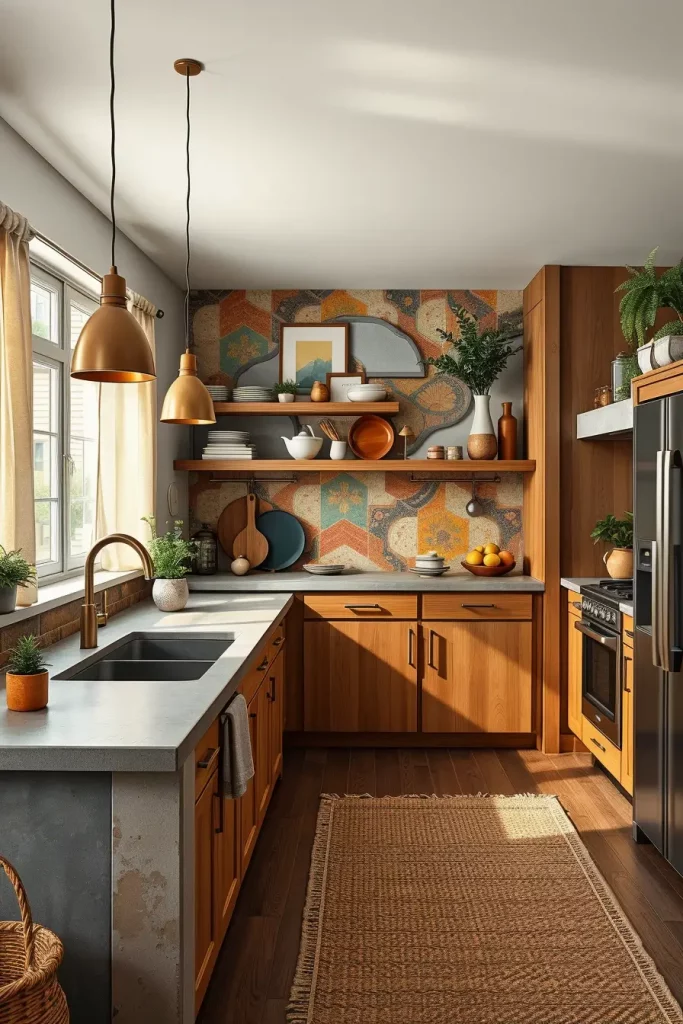
I have worked with concrete countertops, sinks or flooring in my projects. These characteristics contrast with natural wood cabinetry or colored backsplash. Particularly concrete islands introduce a modern edge without sacrificing eclectic details such as open shelving or reclaimed materials.
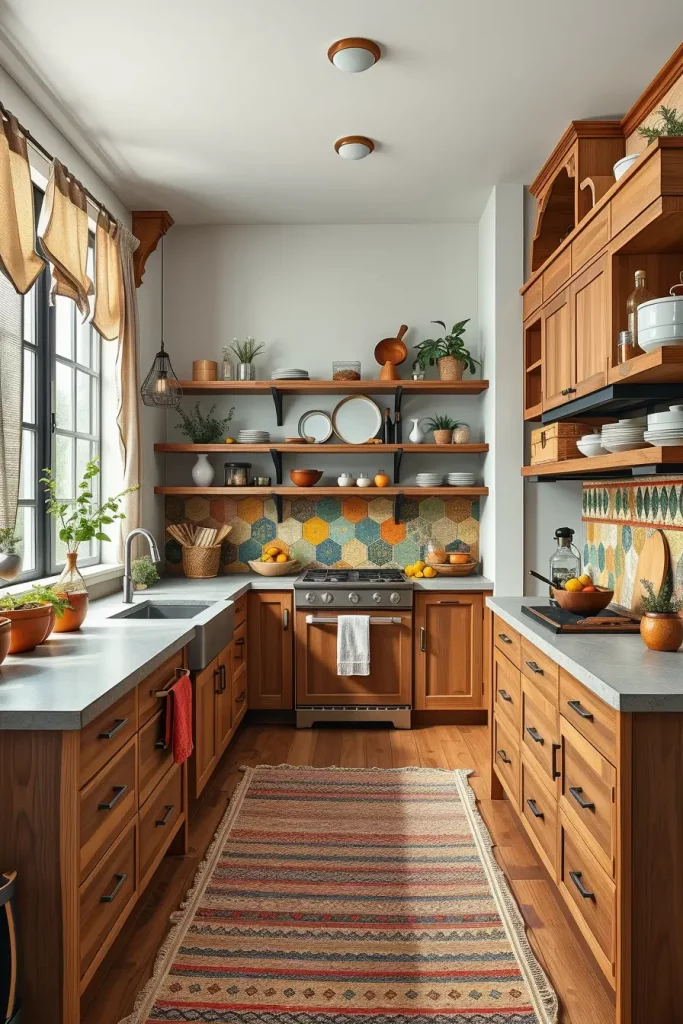
In my personal opinion, concrete details will make eclectic kitchens feel new and modern. Dwell design specialists tend to highlight the combination of concrete with modern and rustic finishes, which is also the case with me. It is a substance that defies convention but pays off the imagination.
What I would include here is balance advice. Concrete may be too cold, so I usually recommend balancing it out with warm fabrics, such as linen curtains or woven carpets, to warm up the appearance and make the kitchen welcoming.
Blending Warm And Cool Tones In Textures
Blending warm and cool colors is one of the best methods to establish balance in an eclectic kitchen. I have observed that a combination of warm wood cabinetry and cool stone or marble surfaces gives a welcoming but elegant appearance. Warm colors are comforting, and cool colors are refreshing, and they create a balance of harmony that allows creativity to flourish.
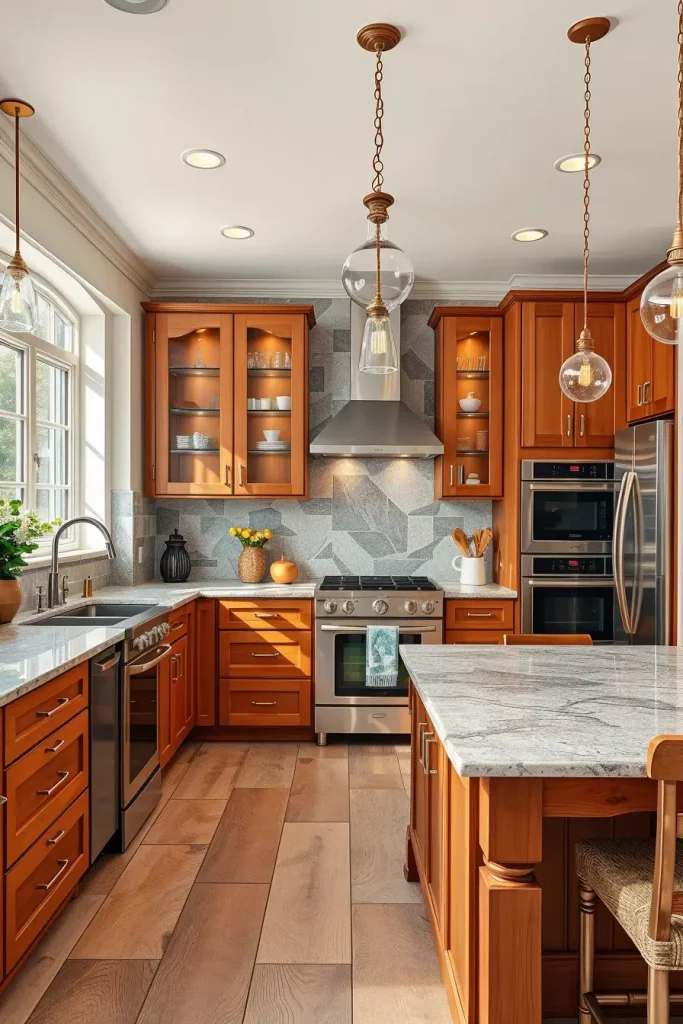
I tend to use this technique with wooden floors or accents and smooth concrete countertops or stainless-steel appliances. Gray stone backsplashes are a good contrast to the warm and honey-colored wood. Metal fixtures or glass pendant lights, linen curtains or rugs are accessories that add cool or warm, respectively.
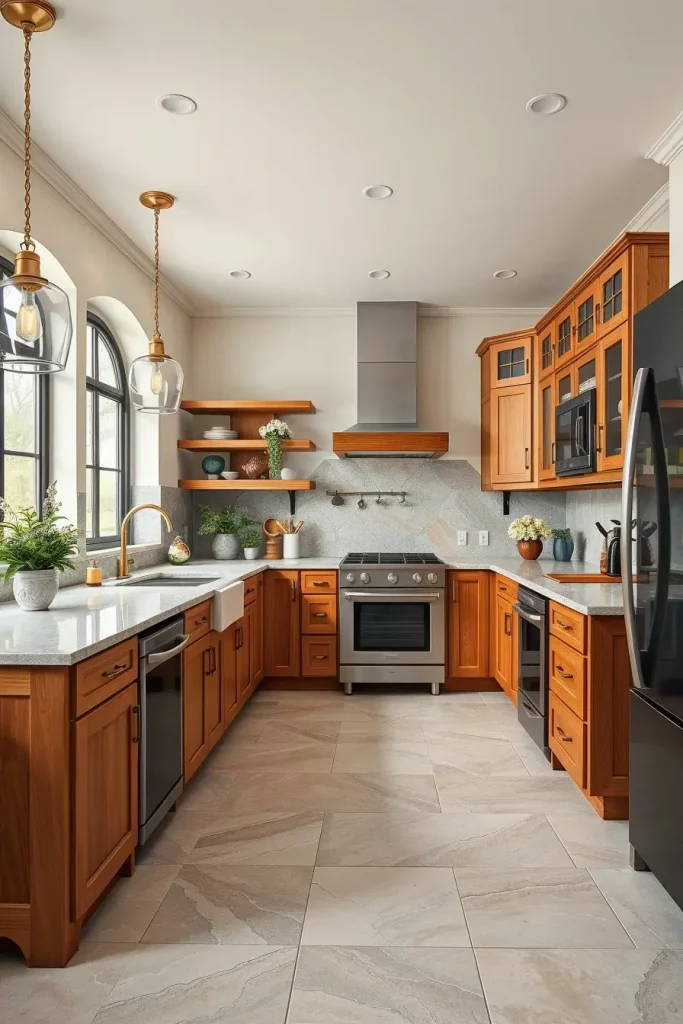
In my experience, such balance makes eclectic spaces appear purposeful. Opposite colors do not make a design flat as Architectural Digest stresses, but create dynamic layers. I concur with this entirely–there is danger of excessive coziness, and of excessive coolness making the room seem sterile.
I believe that this part can be reinforced further by including tips on the wall colors. The warm and cool textures can be united by soft gray or cream walls, which will make the eclectic style seem united.
Layering Materials For A Rich Eclectic Look
The eclectic kitchen design is all about layering, and natural textures make it possible. I like to mix wood, stone, brick and marble in one space as each layer can add depth and character. This design style makes a kitchen look like a narrative of the materials and styles that have been gathered over the years, instead of a design that appears too homogenous.
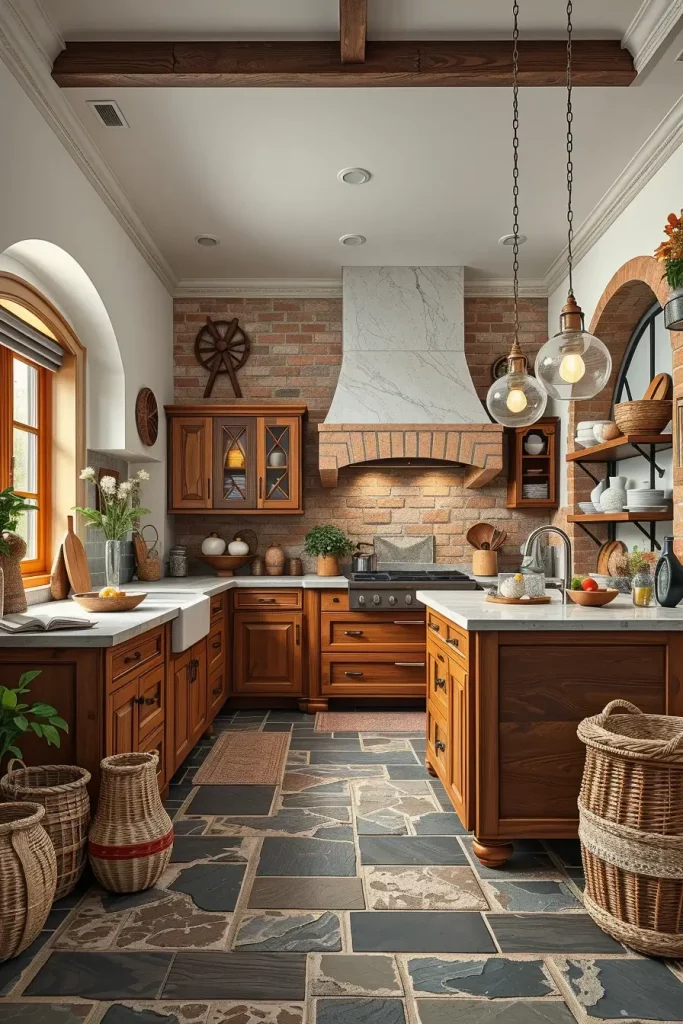
I could also create a kitchen that has wood cabinetry, marble island, and a brick back splash all united by stone flooring. These textures are focused on by layered lighting (pendants, under-cabinet LEDs, and wall sconces). The layered appearance is enhanced even by minor details such as woven baskets, ceramic dishes, or linen runners.
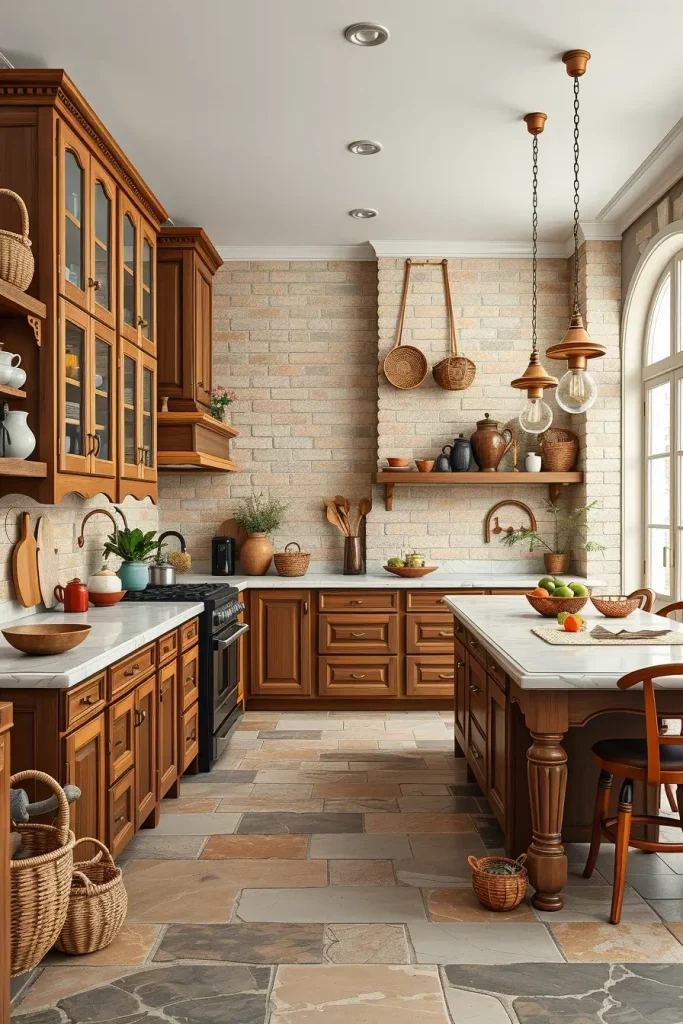
On a personal level, I believe that eclectic interiors are exciting because of the layering. It is not too repetitive to layer the textures as Better Homes and Gardens suggest, and it is possible to express personal style. I have witnessed clients smiling after making their kitchen look like a well-designed environment and not a showroom.
What I would include here is the value of balance. The design should not be overloaded with textures, and I would suggest three or four natural materials as the foundation and place smaller decorative elements over them.
Unique Cabinetry With Natural Finishes
A kitchen is characterized by cabinetry, and in eclectic design, it is the ideal location to experiment. To highlight the organic aspect of the eclectic style, I tend to use cabinetry that has a natural finish. Open-grained wood, painted cabinets with worn edges, glass-fronted doors with wooden frames all bring personality and texture to the space.

I prefer to combine the styles of cabinets–lower cabinets in deep wood colors with upper cabinets in light finishes. Certain areas of cabinets may be substituted with open shelving, where stoneware or copper cookware is on display. Reclaimed wood cabinets are green and provide uniqueness and when compared to metal handles or stone countertops.
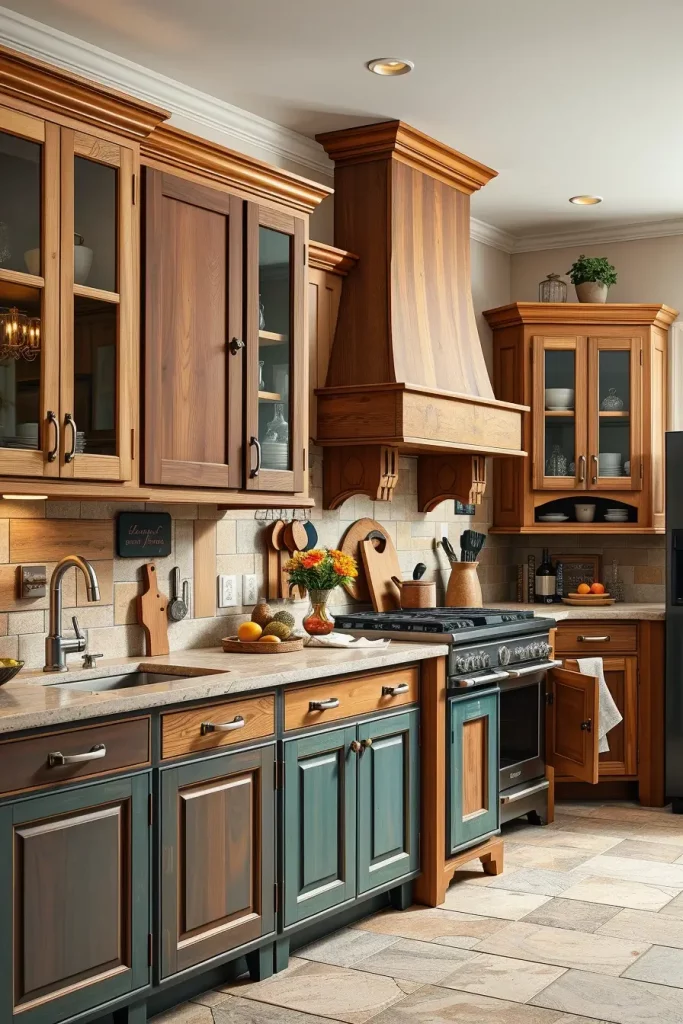
I have found that clients usually like cabinetry as a place to express themselves. House Beautiful often mentions that when cabinets are not uniform, the kitchen feels more intimate, and this has proven to be the case. Eclectic kitchens are comfortable and stylish with natural finishes that bring warmth and texture to them.
I would include information on the interior of the cabinets. Open shelving within doors, or pull-out storage of natural wood, adds functionality as well as design, making eclectic cabinetry as useful as it is attractive.
Open Shelving That Highlights Organic Beauty
Open shelving is considered to be one of the most effective methods to display the natural textures in an eclectic kitchen. I have created areas where wooden shelves are used to showcase groups of stoneware, glass jars, or woven baskets and the effect is always welcoming and natural. Open shelving promotes creativity and also has a functional role to play.
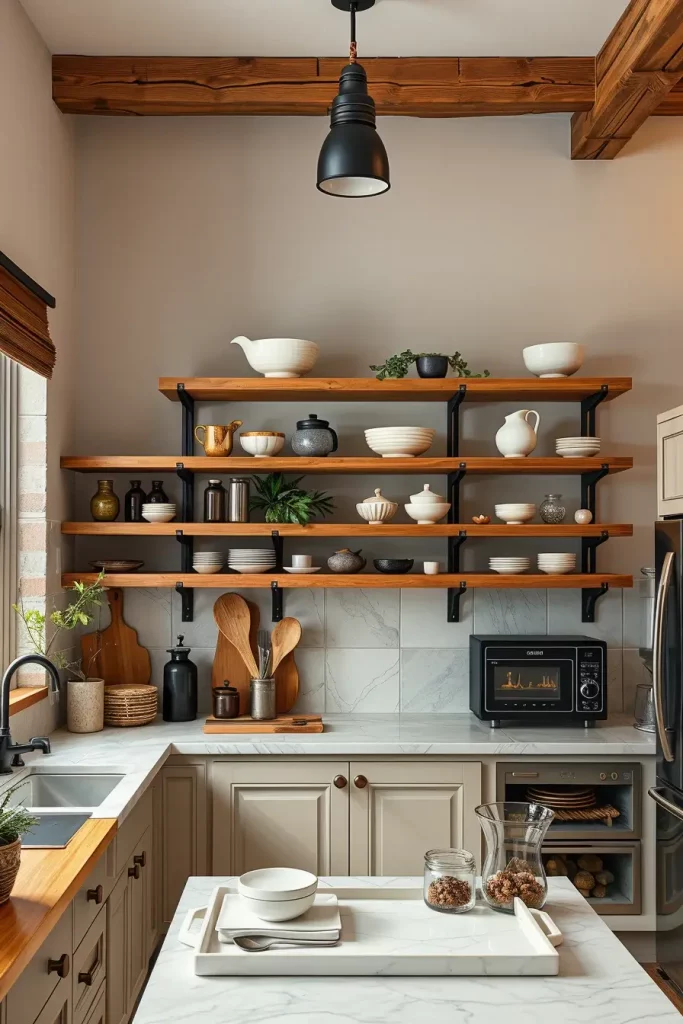
I tend to prefer reclaimed wood or bamboo when selecting shelving as a rustic but contemporary look. Black metal or brass brackets provide an industrial touch that can be easily mixed with eclectic style. I would recommend that natural materials such as ceramic bowls, wooden cutting boards, or marble trays be displayed on the shelves to ensure that the textures remain the same.
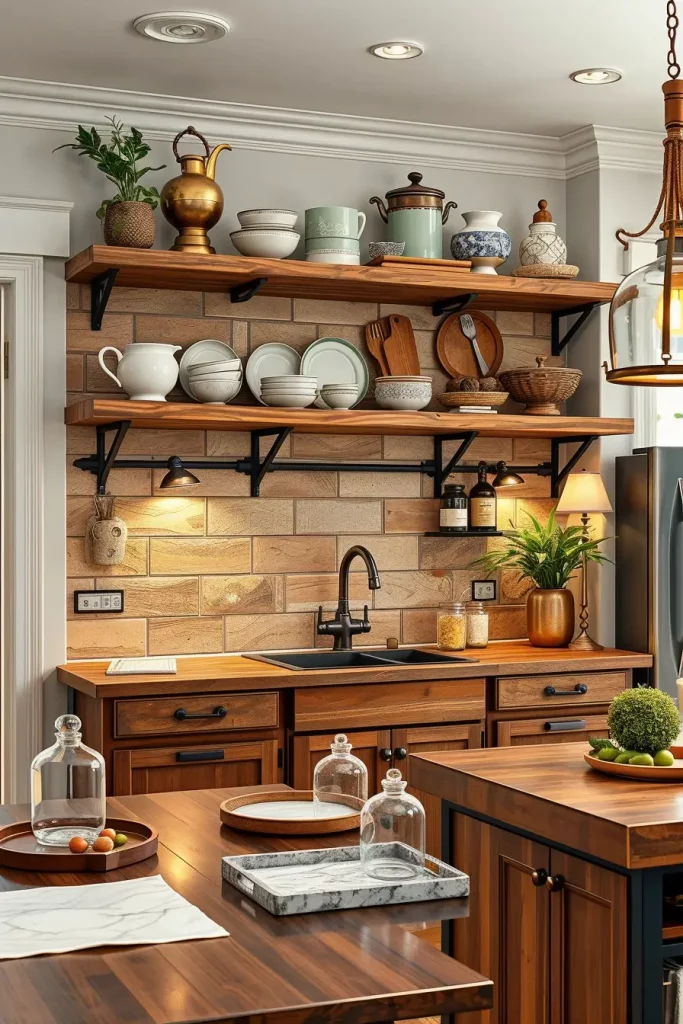
In my opinion, open shelving gives a kitchen life. Elle Decor experts frequently suggest open shelving in eclectic rooms since it can be flexible without making the design complicated. I could not disagree more–it does not make the room look too closed off, but emphasizes the beauty of nature.
The only thing that would improve this part is the focus on lighting. The presence of under-shelf lighting or spotlights above open shelving will make the natural elements in the kitchen the center of attention.
Eclectic Kitchen Islands With Natural Textures
Kitchen island is usually the focal point of eclectic design and I enjoy using natural textures to make it shine. A stone or marble countertop on a wooden island makes a workable surface and a visual focal point. The combination of materials will allow the island to balance the modern and rustic impact.
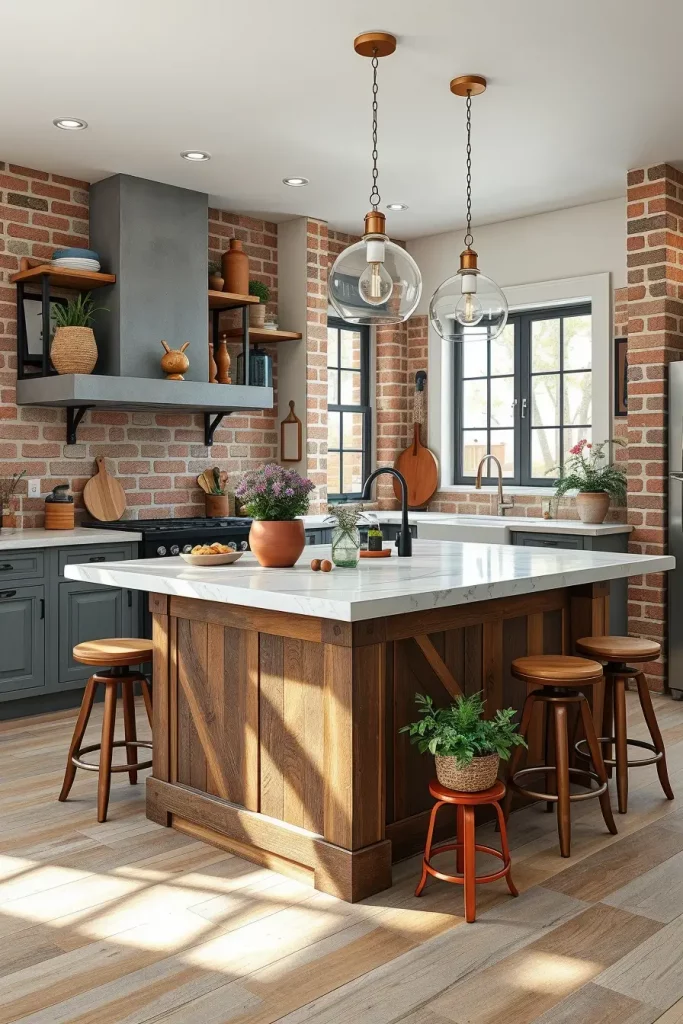
I have created islands that have wooden foundations, marble tops and open shelves below. Some are concrete surfaces with wood stools or brick decorations on the sides. The addition of functionality like built-in storage or open racks to display cookware makes the island appear eclectic and yet practical.
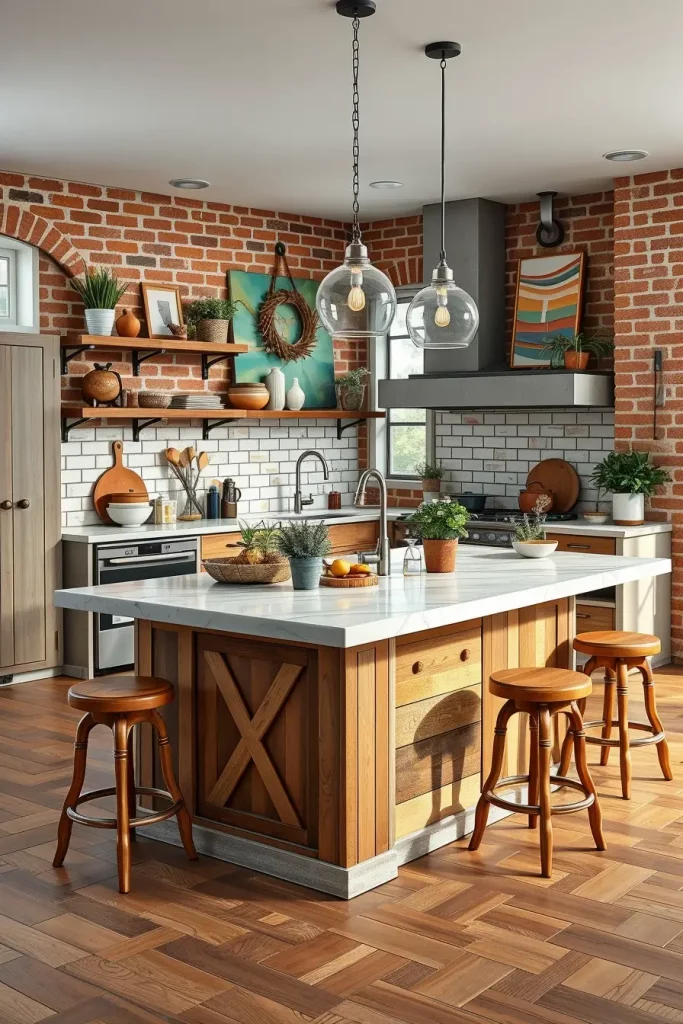
The island usually dictates the mood of the whole kitchen in my case. Dwell notes that islands are the best place to play with bold materials, and this piece of advice can be handy in eclectic spaces. The mixture of textures allows the island to narrate the story of the design without overwhelming the room.
I would add greenery here–potted herbs or a vase of fresh flowers on the island would soften the natural materials and would also bring life to the eclectic space, making it all the more alive.
Reclaimed Materials To Be Sustainable
The use of reclaimed materials is one of the most gratifying elements of eclectic design. I have done kitchens where old wood beams, used stone, or reclaimed brick provided the room with immediate personality. In addition to aesthetics, this style is sustainable, which is becoming a key aspect of contemporary design.
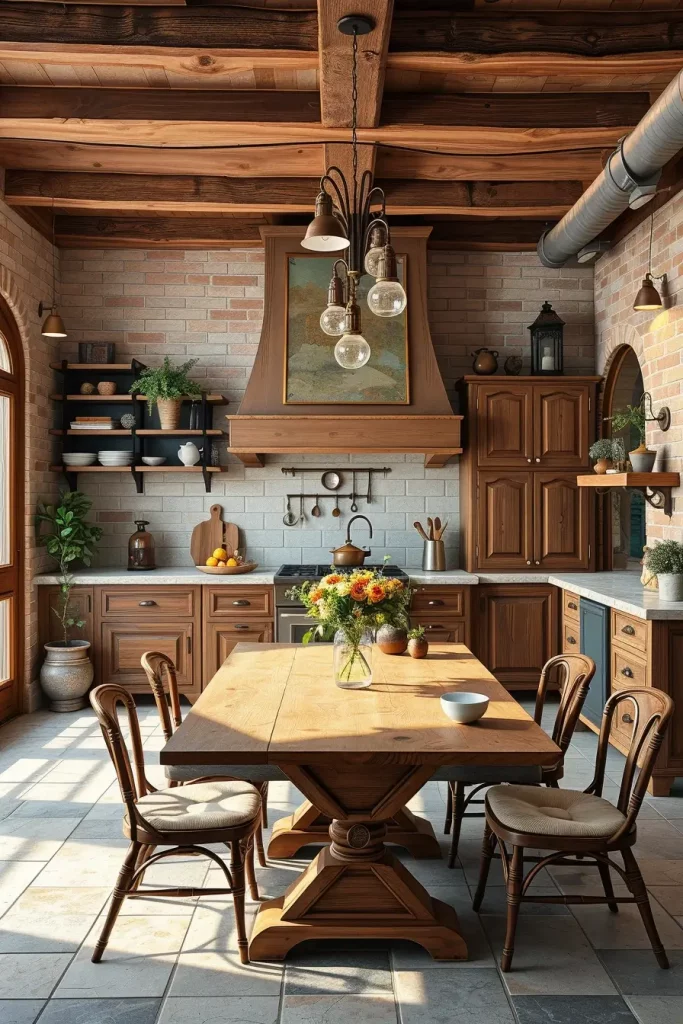
I tend to use reclaimed wood in cabinetry, shelving or flooring. Stone that has been salvaged can be used to create impressive countertops, and old tiles can be used to create a colorful backsplash. The kitchen can be eclectic and sustainable even in terms of furniture, such as a reclaimed wood dining table combined with modern chairs.
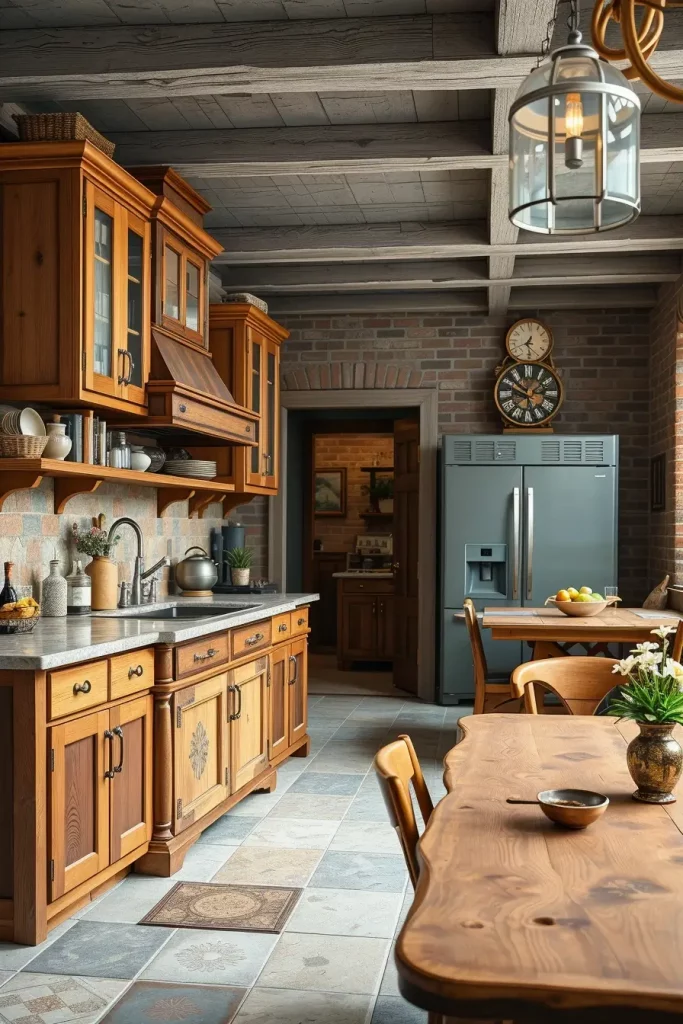
I consider this to be a significant approach since it links design with environmental responsibility. According to Apartment Therapy, reclaimed materials add history and uniqueness that can never be duplicated with new products. I enjoy telling clients that their kitchen materials already have a story and add more character to their home.
In order to reinforce this section, I would suggest referring to finishes. When reclaimed materials are treated with protective coating, they are still durable and safe and at the same time retain their natural beauty.
Mixing Metals With Wood And Stone
The use of metals in eclectic kitchens is an underestimated factor particularly when used in conjunction with wood and stone. I have observed the way brass, copper and stainless steel fixtures sparkle on natural textures and provide depth and contrast. The combination of these components makes the design look curated and not too polished.
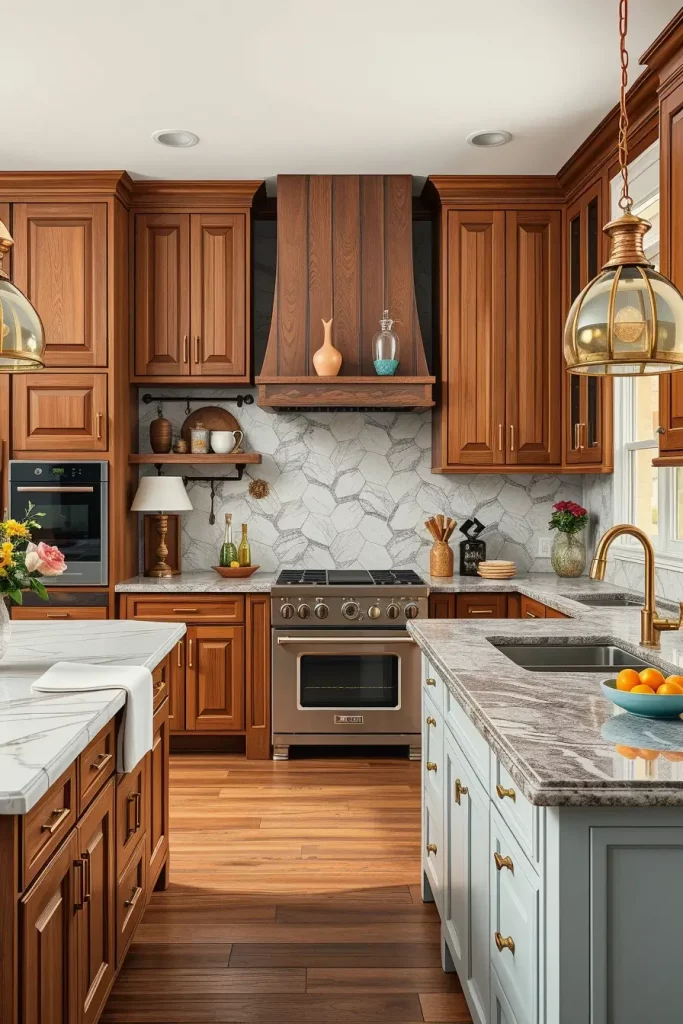
I tend to mix wood cabinets and brass handles, marble countertops and stainless steel appliances, and copper pendant lamps over a stone island in my projects. There is also metal-framed shelving or barstools that provide an industrial feel that balances the rustic feel.
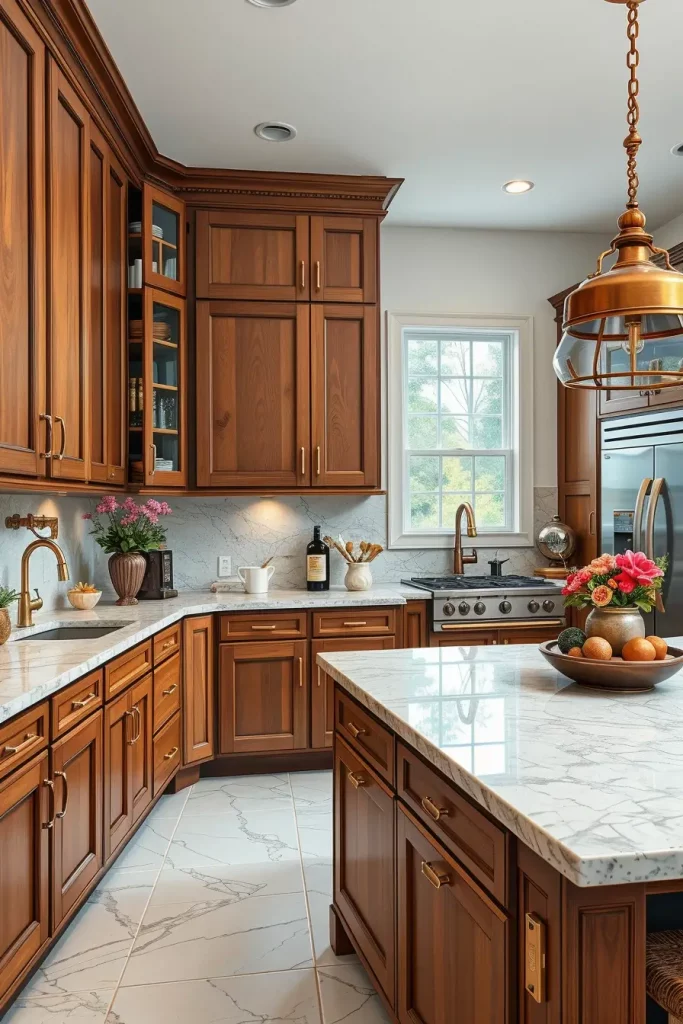
Personally, I enjoy the way metals reflect the light and make the kitchen look brighter and more vibrant. Mixed metals are recommended by Domino Magazine to ensure that a design does not look flat and to provide a touch of modernity. This is my personal experience–metals bring the right amount of shine to the warmth of wood and the strength of stone.
In case of expansion, I would recommend adding smaller accessories. Metal trays, cookware or even ornamental bowls provide a glitter and connect the eclectic mix without taking over the design.
Ground Eclectic Kitchens Flooring Options
My initial thought when designing an eclectic kitchen is always based on the flooring. It preconditions all the other things, both literally and visually. A natural stone tile, reclaimed wood plank or patterned concrete can all be used to add texture and authenticity. A patterned floor makes the space grounded and contrasts with bright cabinets or vivid walls, which are so common in eclectic kitchens.
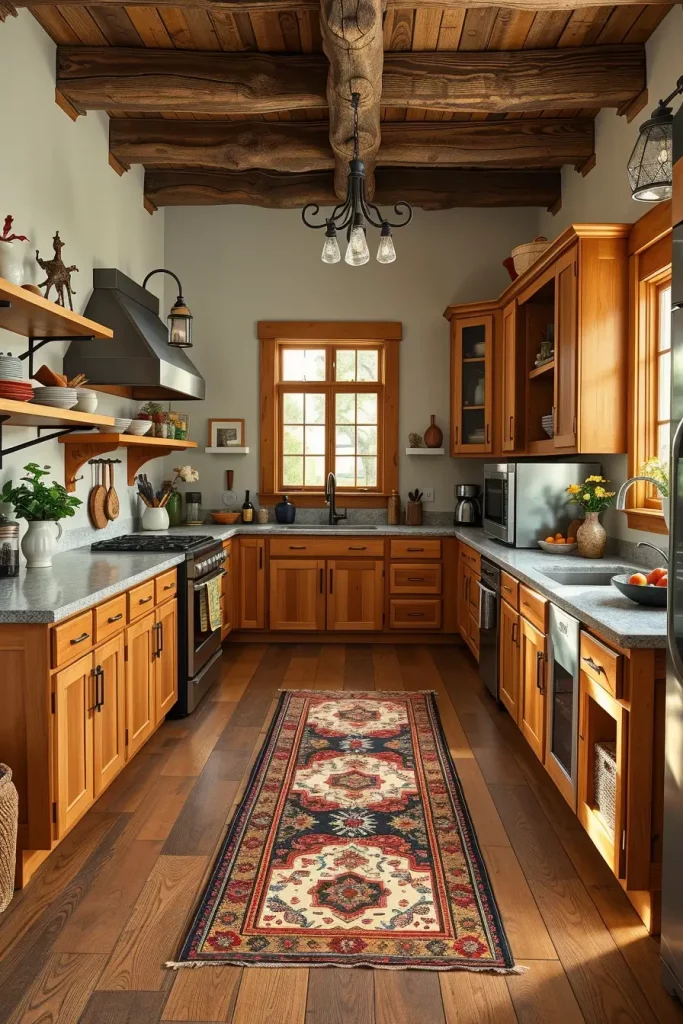
I prefer to use wide-plank wooden floors in such designs as it gives it a warm and strong appearance. It is even more welcoming when paired with patterned runners or rugs. Matte concrete floors also look great when they are combined with organic furniture and wovens. I believe that natural flooring solutions contribute to accentuating the eclectic blend of materials and maintaining the sense of unity in the kitchen.
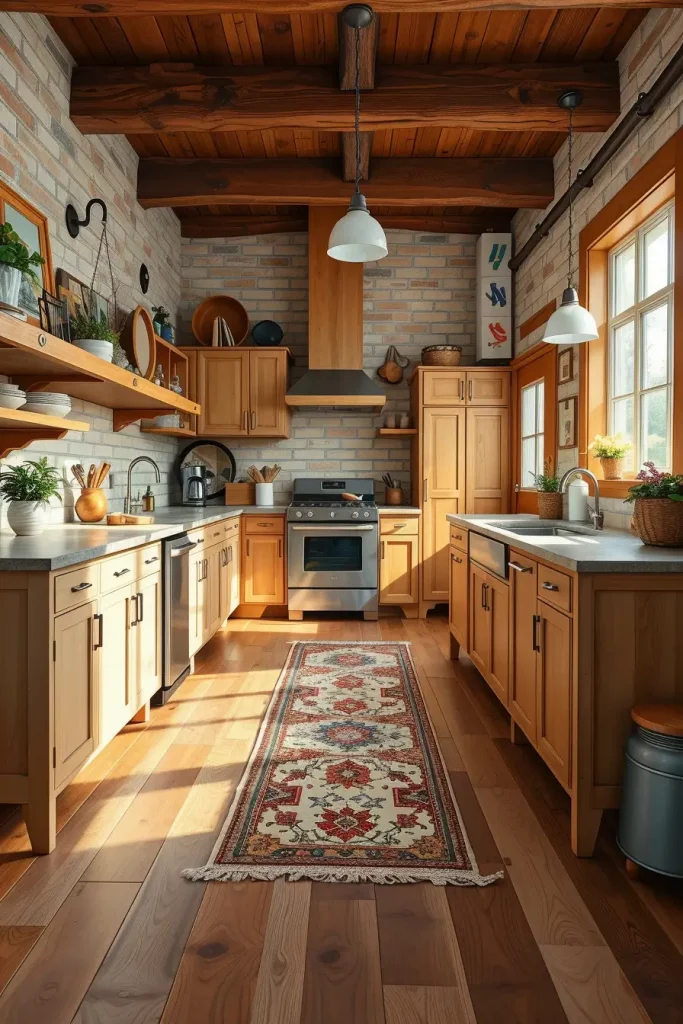
On a personal note, I would always use reclaimed wood floors where I can because it not only tells a story, but it also ages beautifully. Architectural Digest says that reclaimed wood is the most sustainable and provides the best texture to interiors and is one of the most suggested flooring materials to use in eclectic spaces.
To finish this section, I would include underfloor heating facilities, particularly when stone or concrete is selected to ensure that the kitchen is comfortable throughout the year.
Natural Light To Enhance Eclectic Textures
One of the simplest methods of highlighting the richness of eclectic textures in a kitchen is natural light. The materials come alive when daylight falls upon stone counters, wood shelves or woven accents. I will always attempt to work around big windows, skylights, or even glass doors that lead to a patio to maximize the effect.

Natural light is available in every part of the room. Wicker chairs are more colorful, marble veining is more vivid, and metal finishes are soft-glowing. I prefer pure curtains or woven blinds that do not block the sight of the view but allow the light to pass through. Privacy and brightness balance allow the kitchen to be a place where textures can shine.
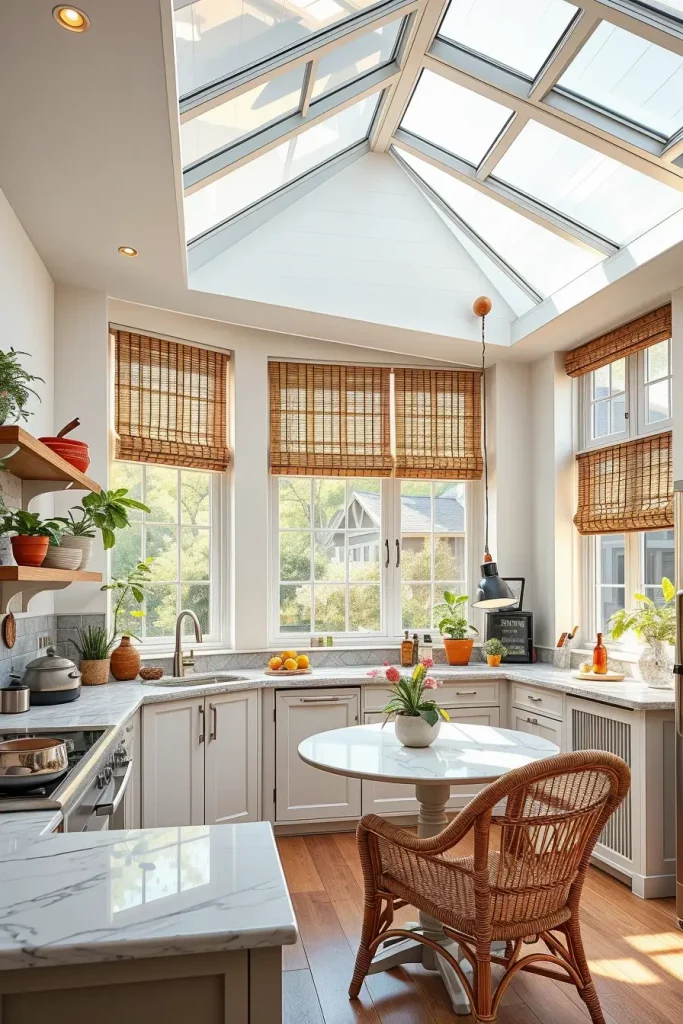
My experience in kitchens that do not have good daylight has been that even with all the natural materials, the kitchen will still appear flat. According to Elle Decor, natural light is the most desirable accessory you can provide to a textured interior. I couldn’t agree more.
I would also add a few layers of lighting, such as pendants, under-cabinet lighting, and wall sconces, so that the kitchen would not lose its depth and vibrancy even at night.
Eclectic Backsplashes With Organic Materials
Backsplashes are an ideal place to demonstrate eclectic personality and use natural textures. I prefer stone slabs, hand-made tiles or even recycled wood panels to build an amazing and practical background. Besides covering the wall, a backsplash also provides a personality to the whole kitchen.
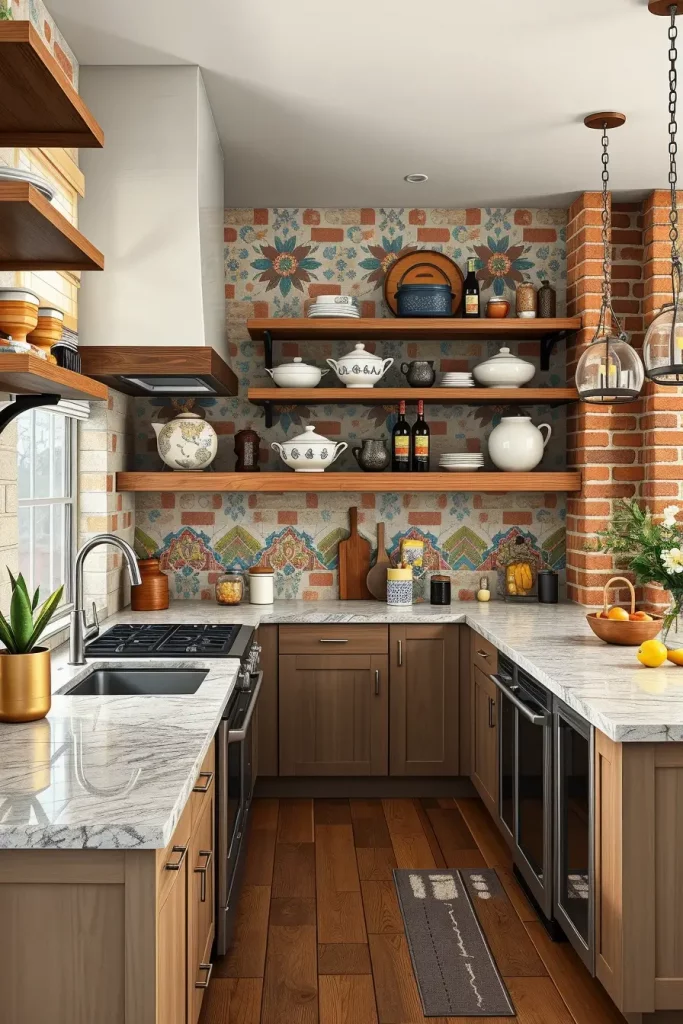
Every material is charming. Stone or marble backsplashes are elegant and zellige tiles are handmade. I once combined a brick backsplash with smooth metal shelves and the two made the place look rough and elegant at the same time. The color of the grout is also important to consider–it can either be blended or contrasted to add some drama.
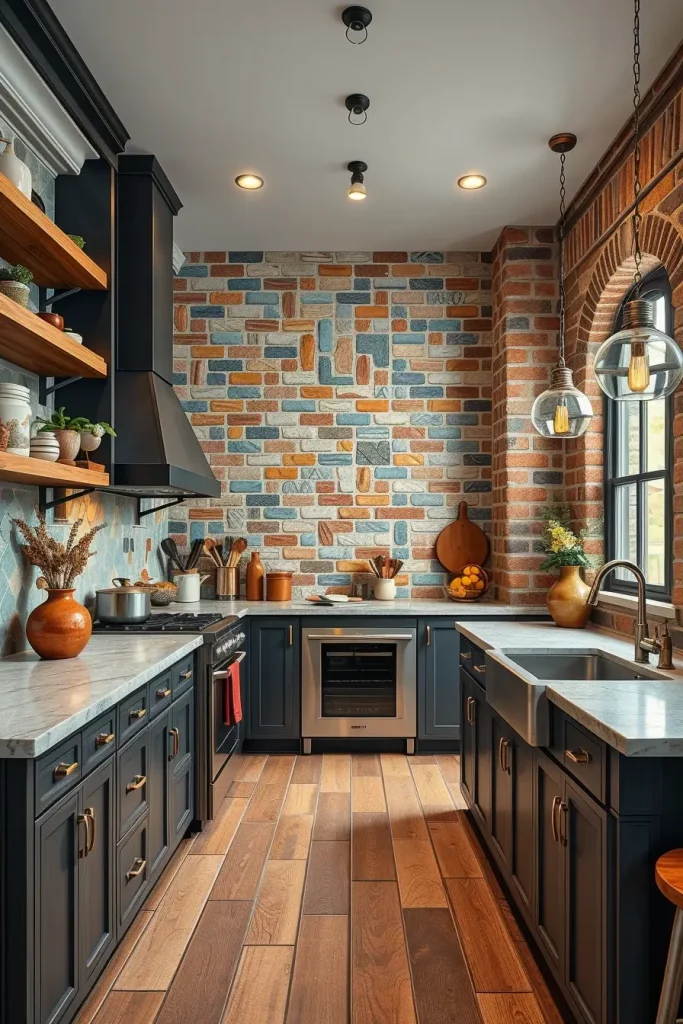
At the individual level, I have realized that I cannot compete with hand-made ceramic tiles in eclectic kitchens. Their minor flaws bring in warmth and personality. Artisan tiles have also been commended by House Beautiful to bring a hint of variation and beauty to contemporary spaces.
The only thing lacking here is functional integration such as incorporating built-in niches or ledges to store spices or plants and the backsplash becomes an aesthetic and useful element.
Crafted Details that Bring a Soul
No eclectic kitchen is complete without handcrafted details. It could be a carved wooden island, hand-crafted pottery on open shelves, or woven baskets to store goods, but all these details make the place intimate and unique. Handcrafted products bring us closer to tradition and art, and the kitchen becomes really personal.
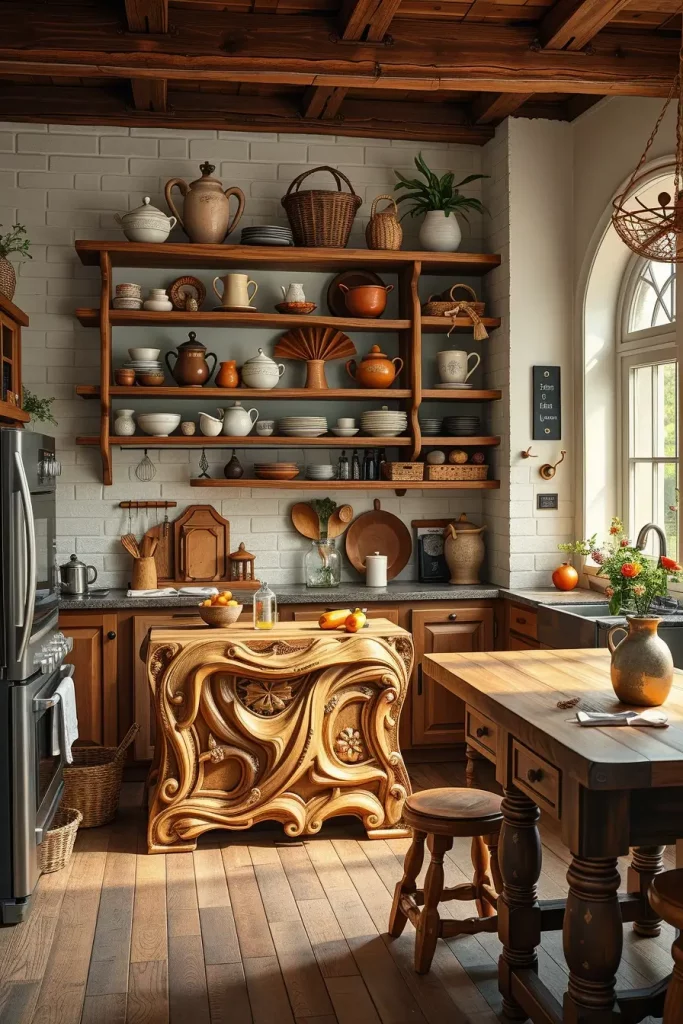
I usually incorporate wooden stools, hand-crafted dishware or a traditional butcher block table. These works are in perfect harmony with more contemporary or industrialized aspects. One such thing is the balancing of old and new by matching hand-thrown ceramic bowls with stainless steel appliances.
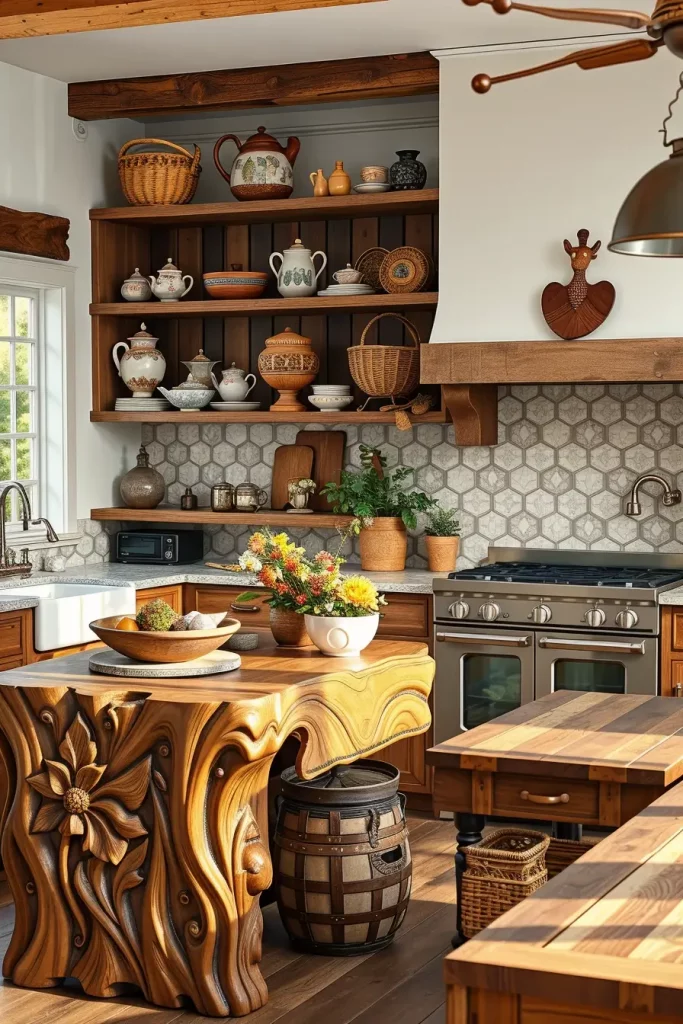
To my mind, these are the things that make eclectic kitchens soulful. Handcrafted decor, according to Better Homes and Gardens, is not only warmer but also makes a home less generic. I have witnessed clients getting excited when something personal and significant is in their kitchen.
I would also recommend including one or two focal handcrafted items like a statement table or an artisan light to ensure that they do not blend in with the rest of the eclectic elements.
Eclectic Seating With Natural Upholstery
Another area that eclectic design is bright is seating. I like combining the types of seating, maybe a banquette with mismatched chairs or stools of various natural finishes. Linen, cotton or leather upholstered seats are warm and comfortable and match textured metal or wood frames.
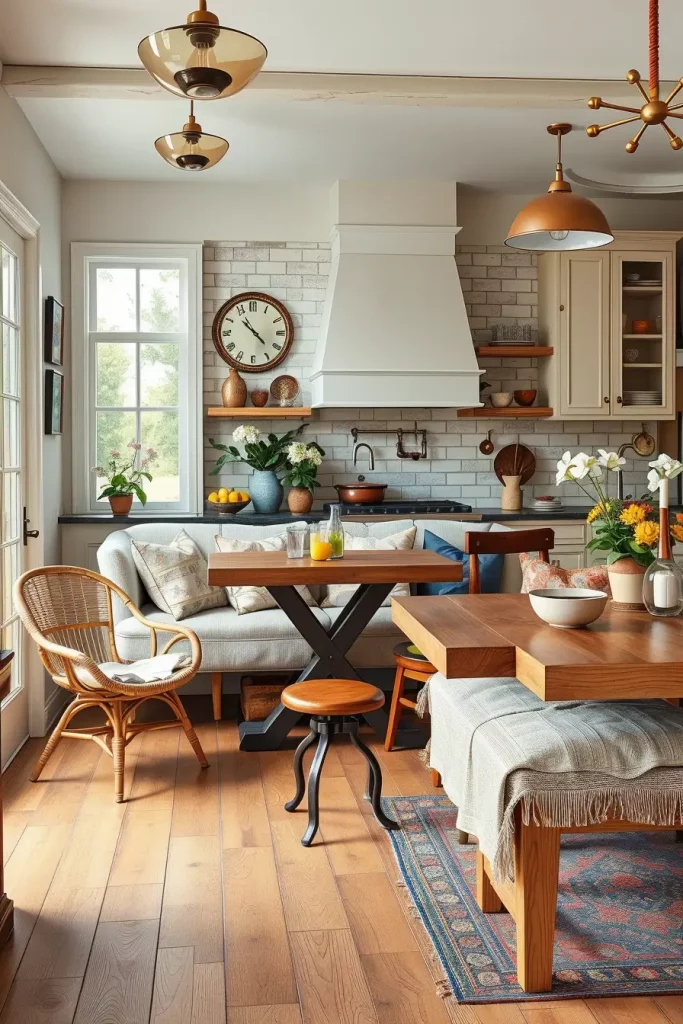
Every sitting decision must be purposeful. In one case, contrast and harmony are created by a rattan chair and a smooth upholstered bench. To make the space look less strict, I usually pile cushions made of natural fabrics to make the space more welcoming. There is also visual rhythm created by mixing high-back chairs with casual stools.
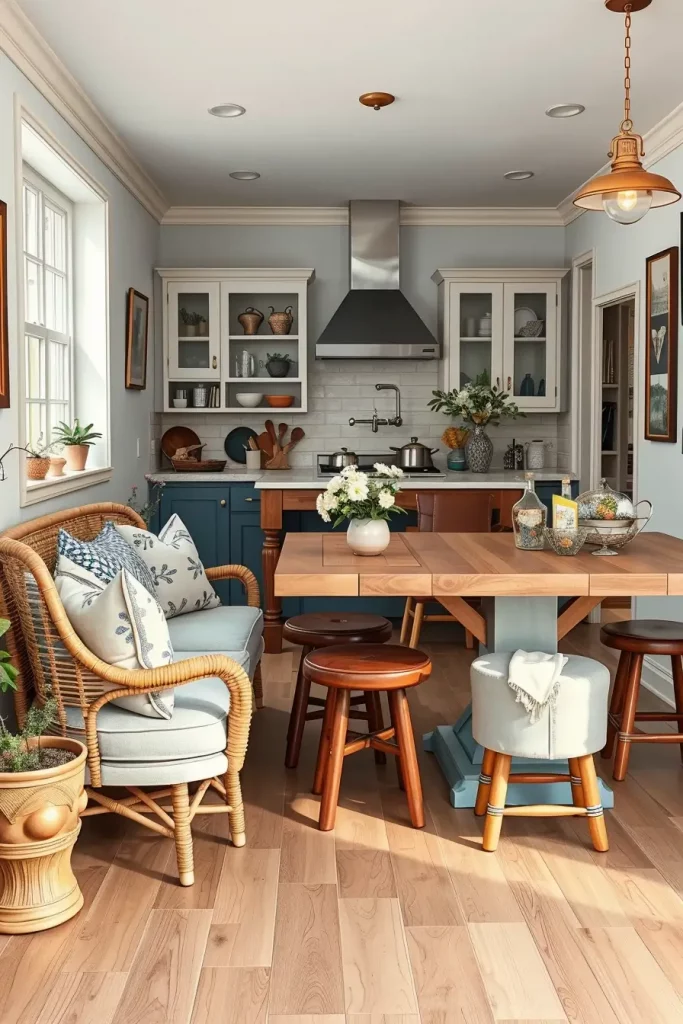
On a personal level, I believe that seating is one of the least recognized methods of demonstrating eclectic style. Domino Magazine tends to point out the seating variety as a way of making kitchens look more friendly and less formal, which is consistent with my experience.
I would also include more accent pillows in natural fabrics and patterns to unite the various chairs and benches to one eclectic appearance.
Plants and Greenery To Add Freshness
One of the easiest but most effective design choices is to bring plants into an eclectic kitchen. New vegetation is a great contrast to wood, stone, or metal surfaces, and it brings energy and liveliness. Instead, I would put potted herbs on window sills or hanging trailers on shelves to give it a casual organic look.
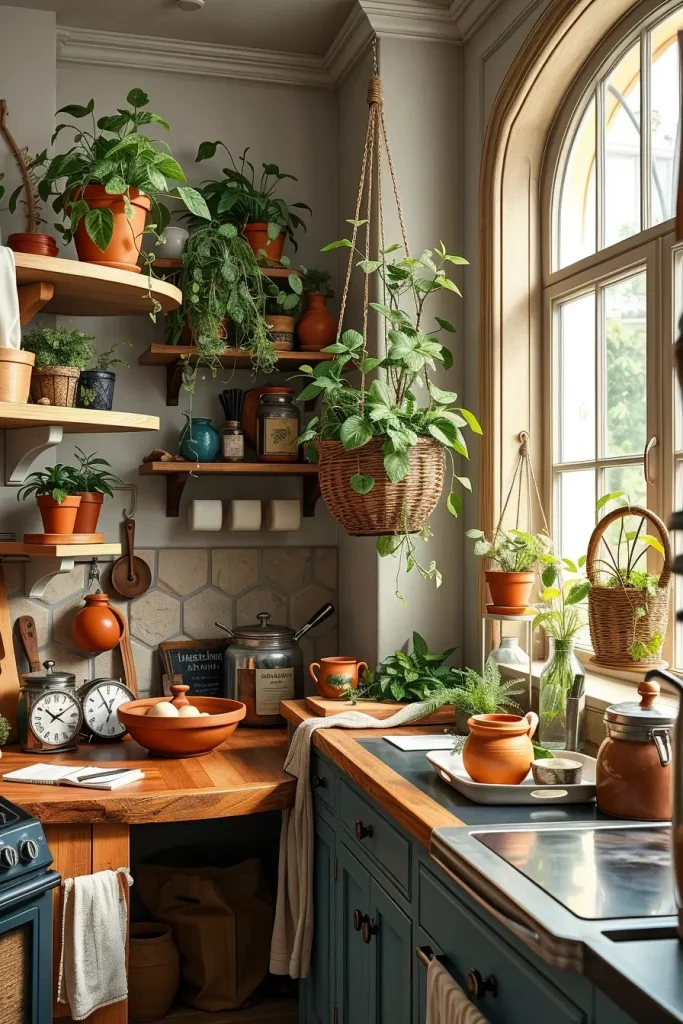
The selection of plants is important as well. Herbs such as basil and rosemary are also useful in cooking as well as being decorative. The bigger plants are given structure by woven baskets or ceramic pots and the smaller succulents playfully add details. Terracotta vases are an ideal match to eclectic surfaces such as brick or stone.
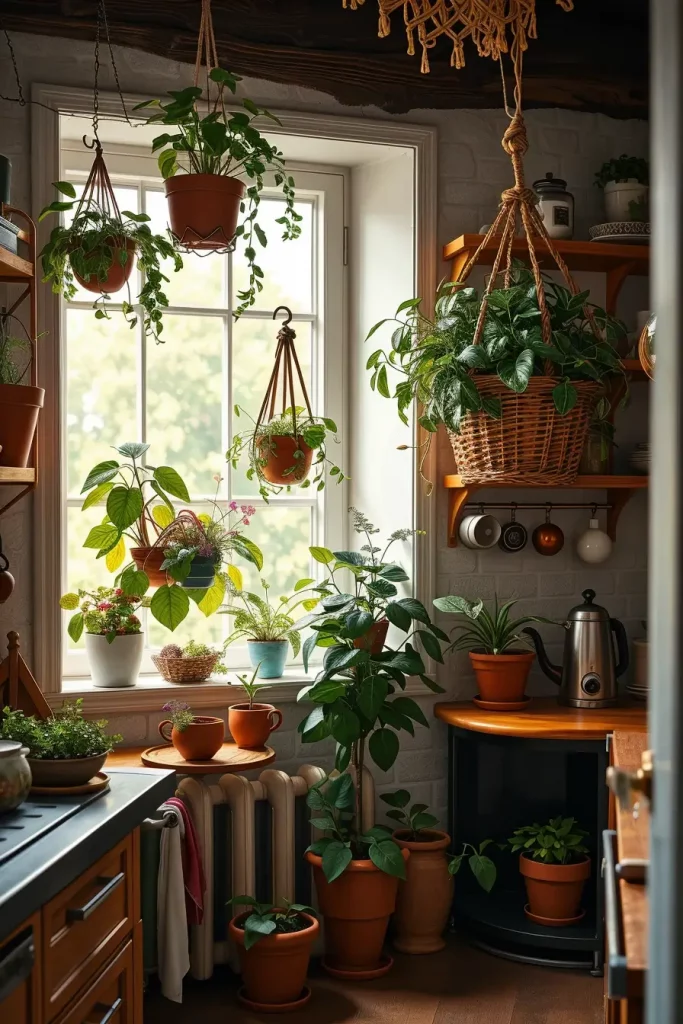
Personally, I have learned that plants immediately make hard materials soft. Another fact that HGTV notes is that greenery is a good counterbalance to bold colors and strong patterns, which can be particularly useful in eclectic spaces.
What is lacking here might be a vertical garden or wall-mounted planters which will not consume much space but will make greenery a feature of the building.
Homely Kitchenware With Natural Tones
The last touches that complete an eclectic kitchen are accessories. I prefer the use of woven baskets, ceramic jars, wooden trays, and metal accents. These minor details provide some natural textures and bring a lived-in quality. One can also easily add accessories to it to fit the season, which is ideal when one prefers to change their environment regularly.
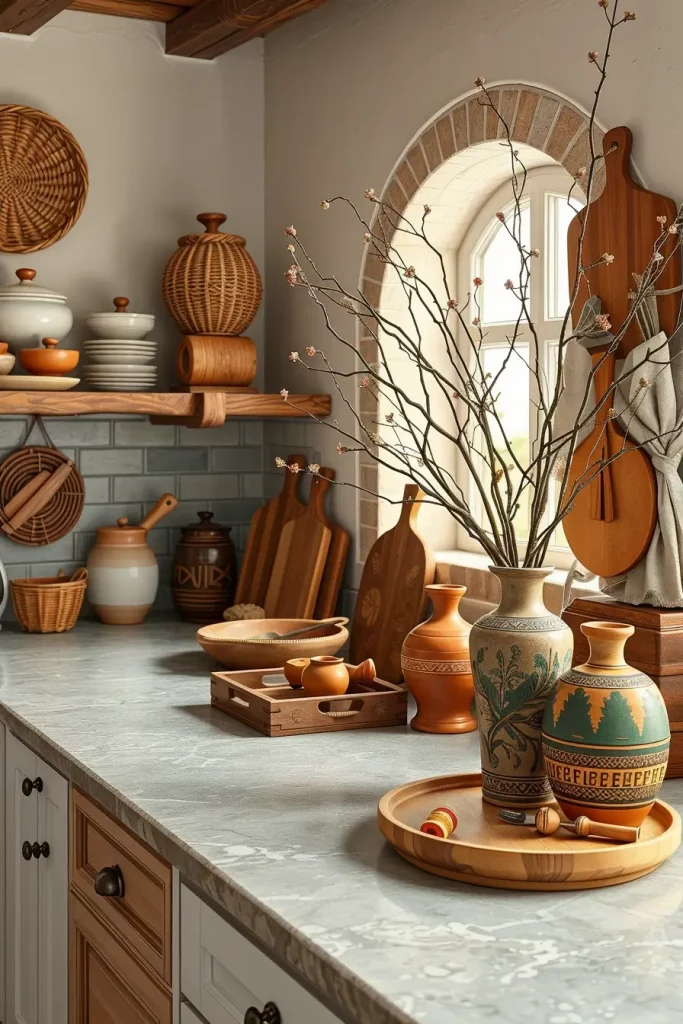
Every item has its role. A wooden cutting board that is hand-carved can also be used as decor when it is leaned against a backsplash. Dried branches are used in clay vases to provide height and form. I usually dress these accessories in three sets to give them a balance and interest.
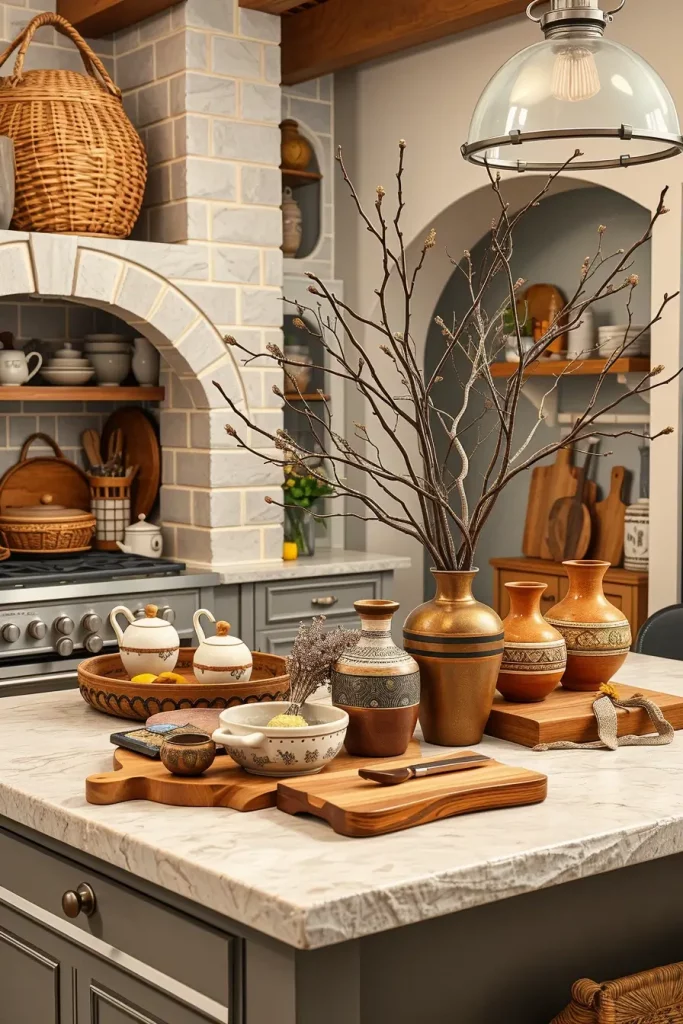
Experience teaches me that accessories play a crucial role in the manifestation of eclectic spirit. Apartment Therapy has proposed that kitchens should be made warm and friendly with personal and natural-like accessories. I agree wholeheartedly.
I would also add more of the craft glassware or handwoven baskets here- they are practical and can fit in any eclectic kitchen.
Carpeted Flooring And Furnishing In The Kitchen
In a natural textile eclectic kitchen design, surprisingly, textiles have a significant role to play. Although kitchens tend to be dominated by hard materials, the use of rugs and fabrics adds softness and warmth. I prefer to have a patterned runner over the wood floors or a textured rug close to the sink to create a contrast to the smoothness of the countertops and cabinets. Linen, cotton or jute fabrics add earthiness to an eclectic blend.
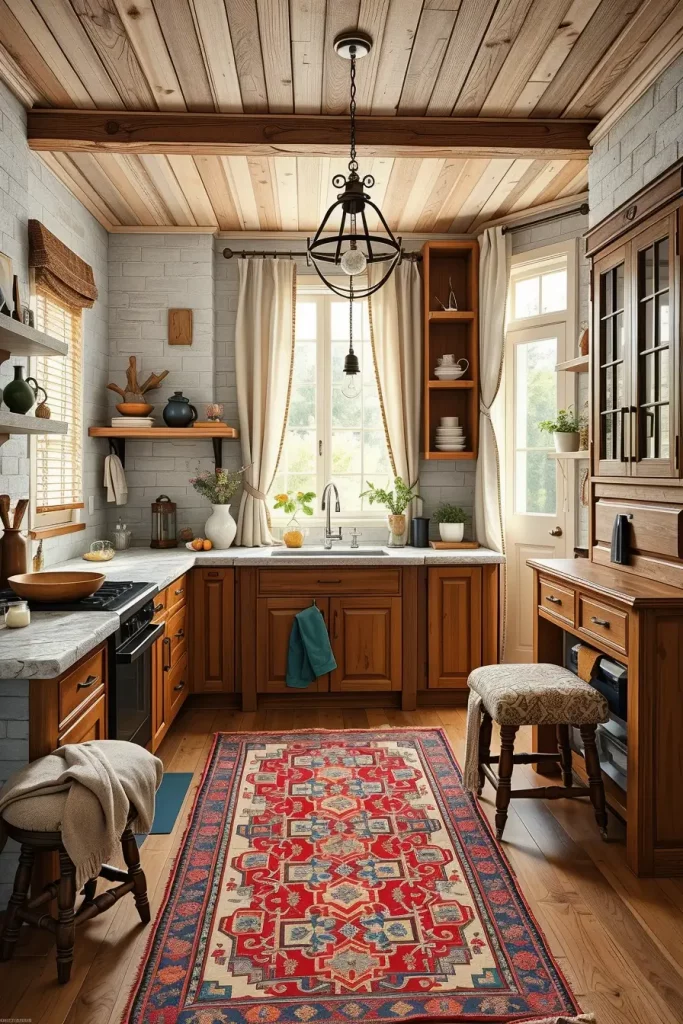
I tend to add woven table runners, linen curtains or upholstered bar stools to bring the room together. An example of a Turkish or Moroccan rug can serve as a colorful centerpiece but still feel natural on stone and wood. The bold contrasts in the room can be softened with textiles of small patterns and earthy tones.
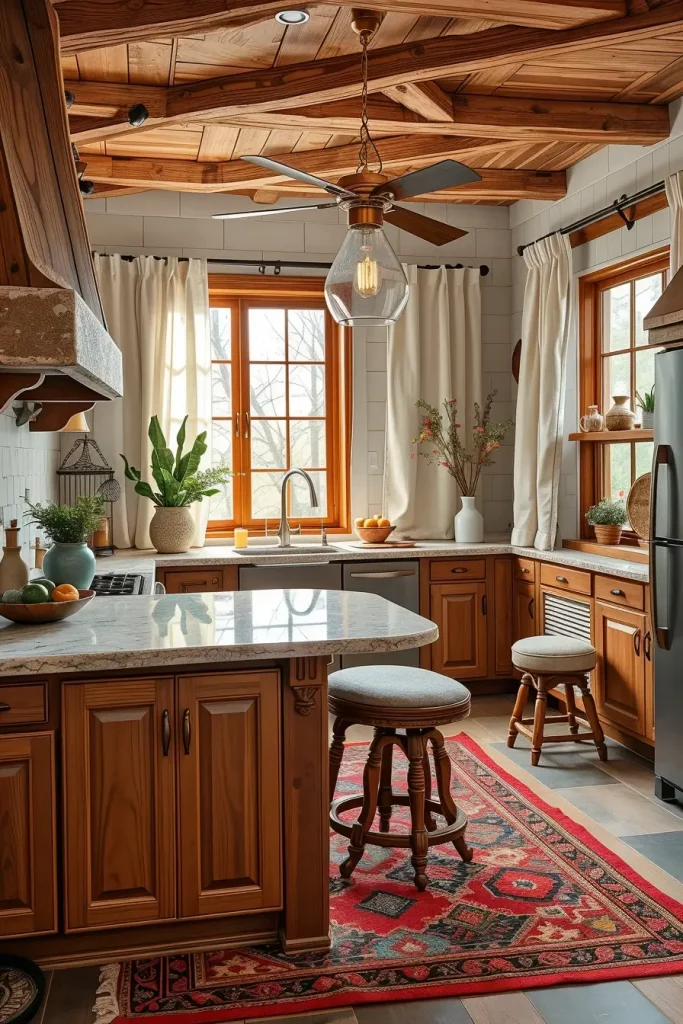
In my case, these items immediately make a kitchen more comfortable. Elle Decor tends to emphasize the way fabrics help bring a sense of coziness to contemporary eclectic homes and I have experienced the same. Clients will always love the way rugs make a place that may be too stiff seem more natural.
I would also include suggestions of washable or stain-resistant fabrics to make this section even more powerful. Kitchens are areas of action and design should always be practical.
Playing With Bold Colors and Neutral Textures
Bold colors are one of the challenges of eclectic kitchens. I have discovered that stone, wood, or clay are the best neutral textures to use as a background to bright colors. An example of a turquoise island would be more refined with limestone counters or natural wood shelves. The colors do not fill the space as the textures do not allow it to happen.
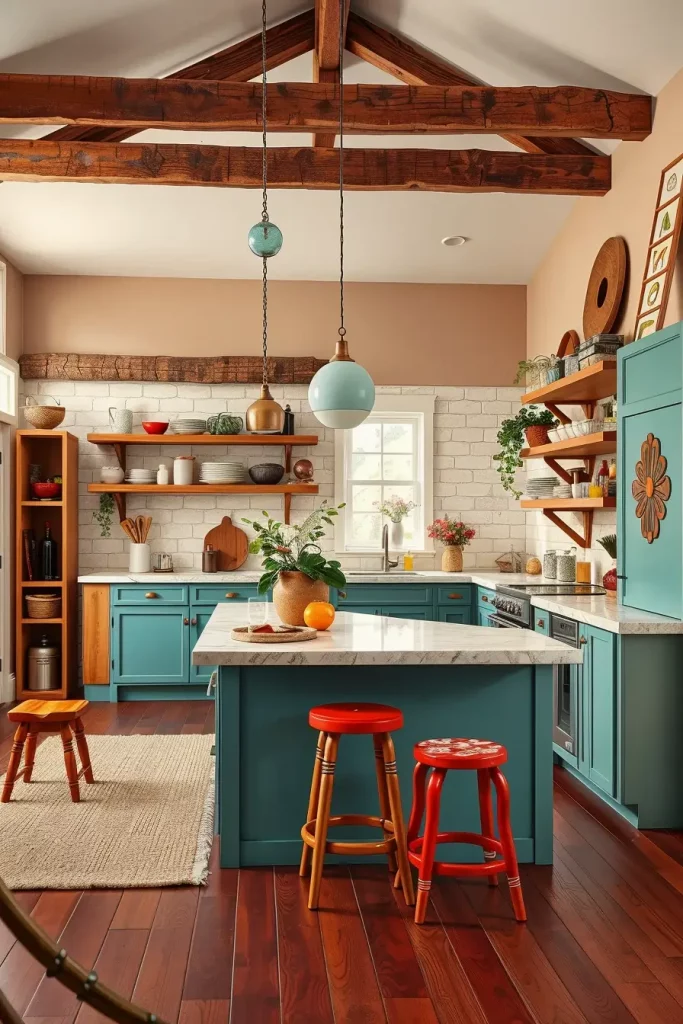
My mix of bold cabinetry and neutral finishes is used when I design. There is a sense of balance in brightly painted stools suspended on a jute rug, or a colored backsplash surrounded by natural stone. These layers make the room look lively but down to earth.
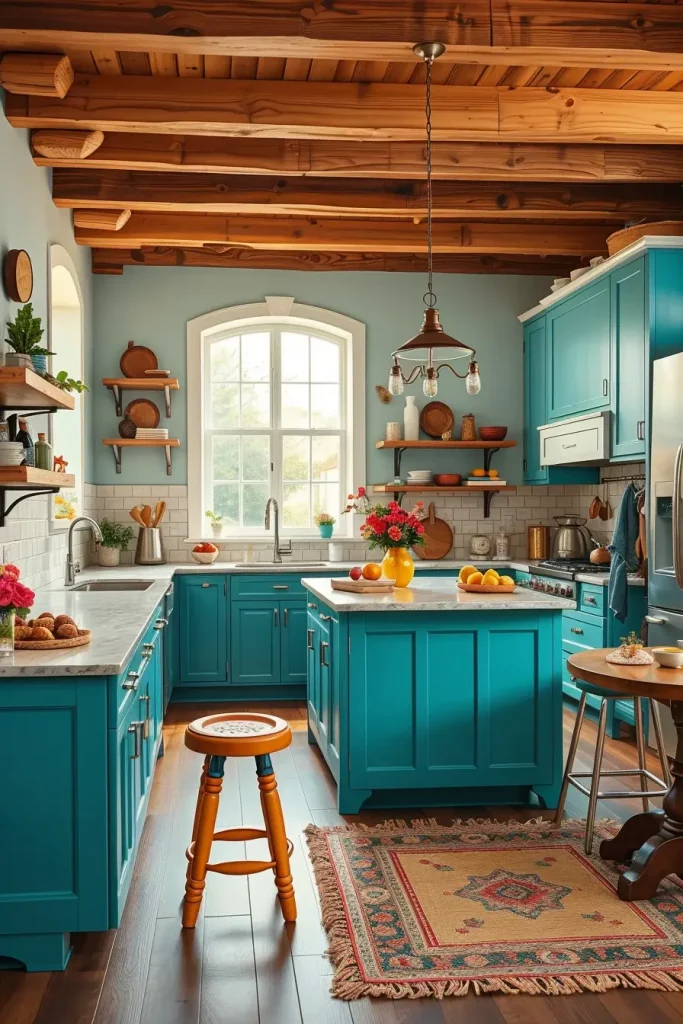
On a personal level, I believe that eclectic kitchens live on this combination of restraint and play. According to Better Homes and Gardens, the secret of bold design is to provide breathing space, and natural textures are the way to do it. The colors may be chaotic without them.
I would include some additional tips here regarding bold colors that should be done with matte finishes. Sometimes glossy paints may conflict with rough surfaces, and matte paints are more natural and earthly.
Eclectic Lighting With Natural Materials
Lighting is also important in highlighting the textures in eclectic kitchens. I prefer pendant lamps of rattan, wicker or clay to bind natural objects into the design. These lamps produce warm shadows that complement the texture of stone, wood and fabric in the room.
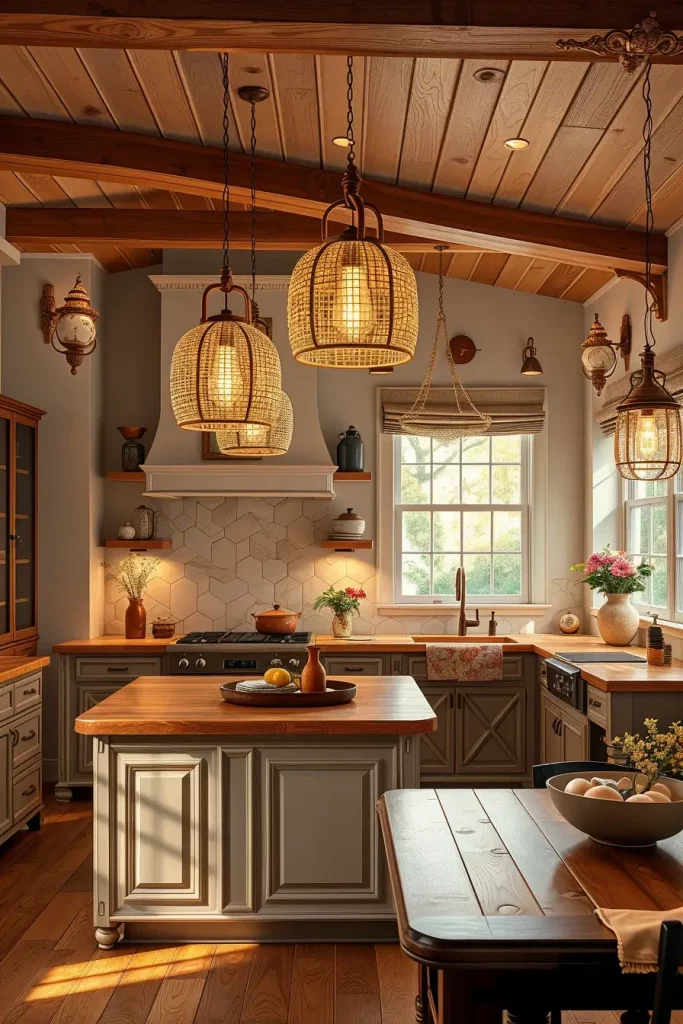
Each fixture matters. The combination of metal sconces on the wall and a cluster of woven pendants over the island is interesting and practical. I have even spotted clay pendant lights with smooth marble countertops–a surprising combination that was very successful.
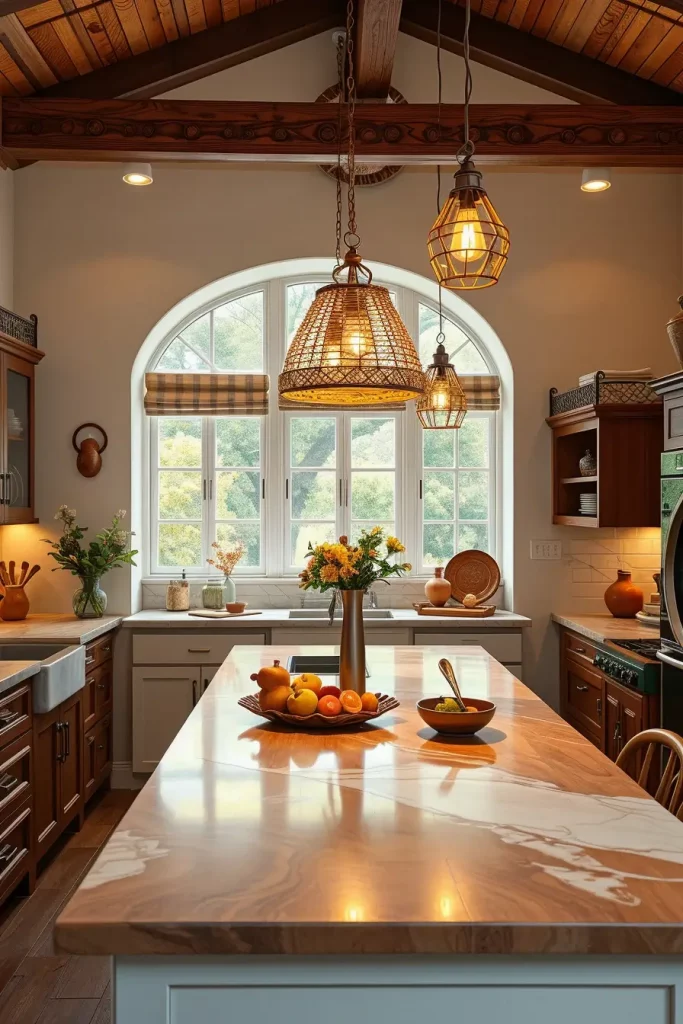
Lighting usually becomes the topic of discussion in my projects. According to Architectural Digest, natural-material lighting is a trend due to the fact that it brings functionality and aesthetics to contemporary rooms. I do concur–lighting is the finishing touch on the eclectic narrative.
The thing I would add to this section is the significance of light layering. Task lighting under cabinets and soft accent lighting around shelves should be used to supplement overhead pendants to emphasize the eclectic textures of the kitchen at any time of day.
Combining Contemporary Furniture with Natural Finishes
I always remind clients that eclectic does not mean old. Contemporary appliances will easily blend into an eclectic kitchen when combined with organic finishes. A stainless steel oven is a beautiful contrast to a reclaimed wood island, or a smooth fridge may be integrated into cabinetry with natural surfaces.
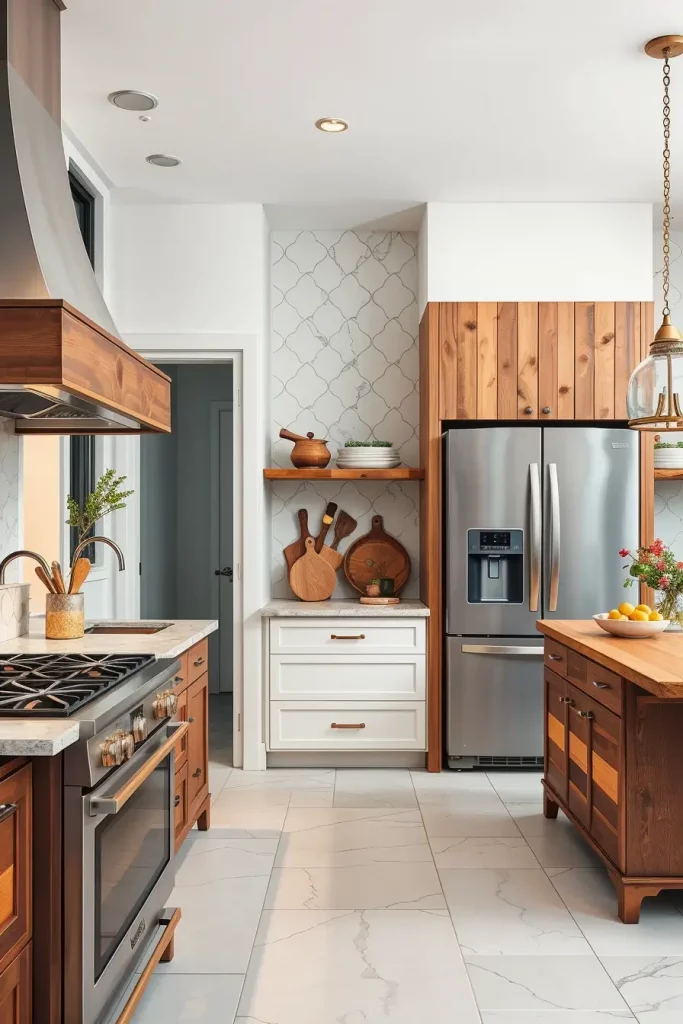
All appliances can be designed purposefully. Induction cook-top, which is black, appears sleek and beautiful on a marble surface, and a dishwasher concealed behind a piece of wood gives a smooth feel. A combination of contemporary functionality and natural design makes the room beautiful and functional.
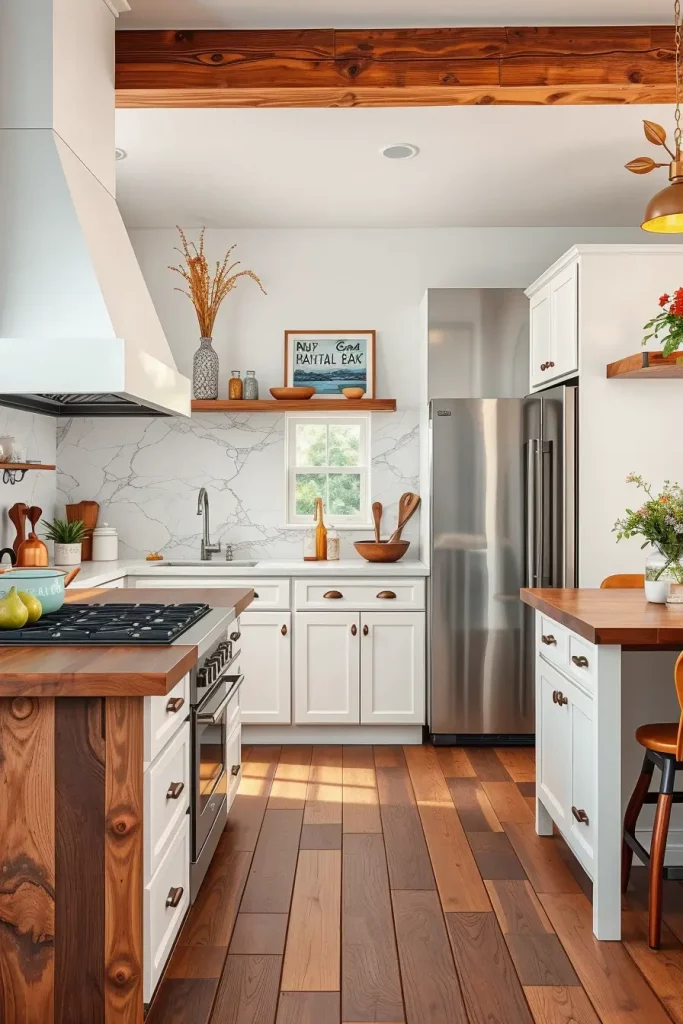
In my opinion, this is what eclectic kitchens excel at, as they do not fear the future, but base it on eternal materials. HGTV is more likely to feature a kitchen that embraces technology without losing its coziness and this balance makes the design sustainable.
I would include more information about such finishes as brushed metal or matte appliances, which go better with natural textures than glossy ones.
Artistic Touches That Underline Eclectic Spirit
Eclectic kitchens are usually what art brings to life. I prefer to include framed pictures, wall sculptures or even colored pottery in the space. Artistic details underline the stratified nature of eclectic design and support the natural theme with handmade or organic objects.
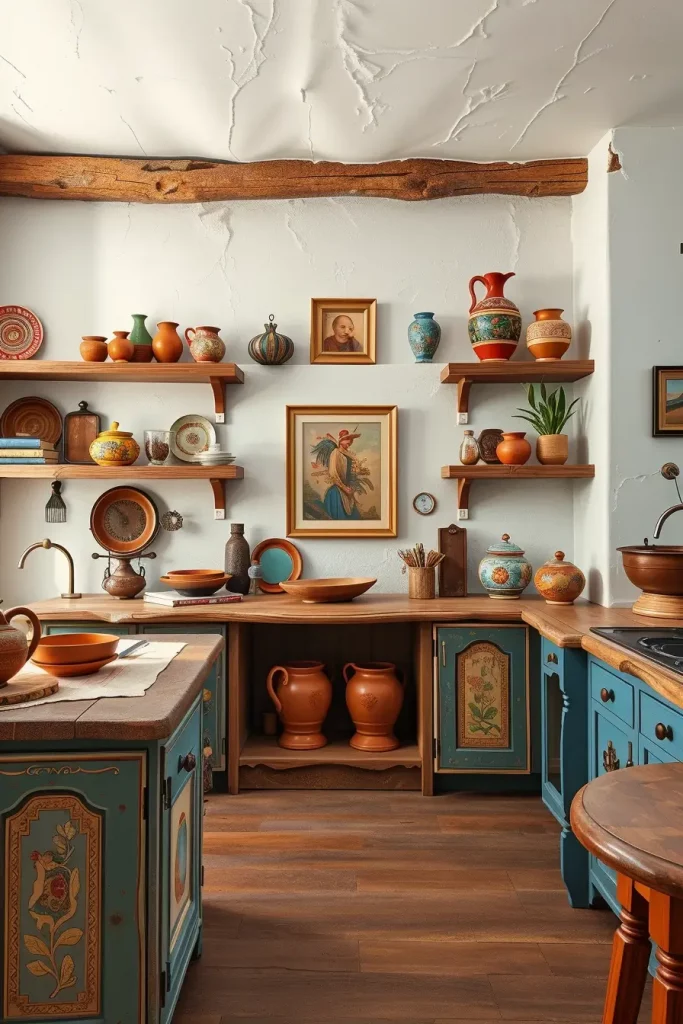
Every detail adds depth. The artistic anchor of a kitchen can be a painting of landscapes, a relief made of clay on the wall, or even the hand-painted front of a cabinet. I would also suggest open shelving to show ceramics, artwork or unique finds that express personality.
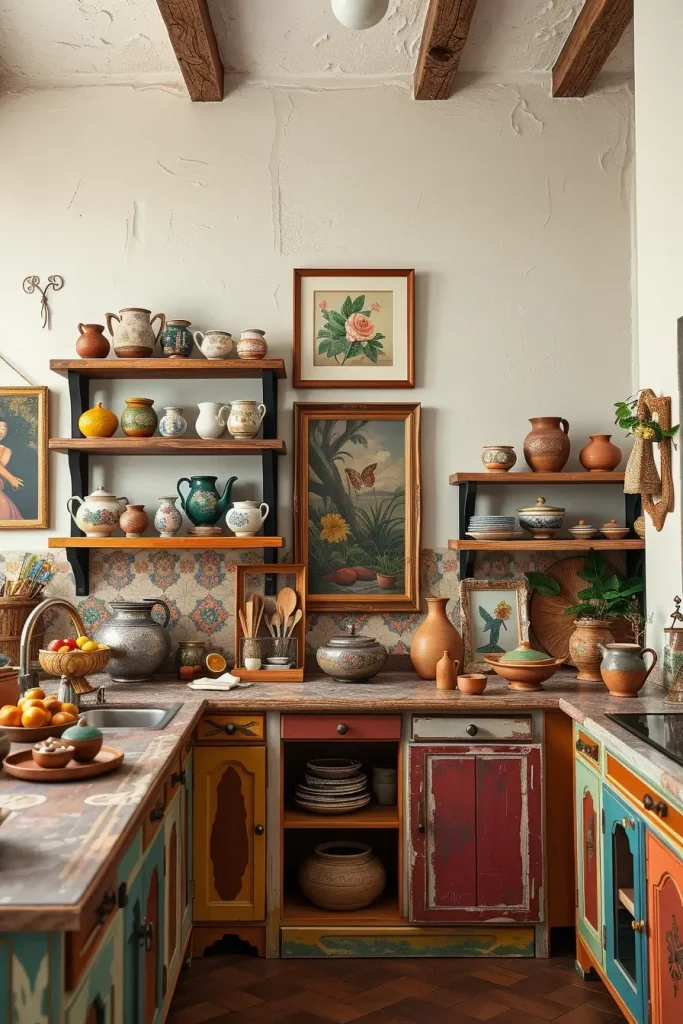
I think art finishes the eclectic narrative. According to Domino Magazine, kitchens must be considered as living spaces rather than functional rooms, and art can do that. With my own work, clients usually feel that their kitchen is really theirs once art is placed in it.
What might be lacking here is more guidance on scaling, bigger works of art on bare walls and smaller and more detailed details surrounding shelves to create balance.
Small Eclectic Kitchens With Big Texture Ideas
Natural textures can make the small kitchens appear rich. Stone countertops, wooden shelves, and rough rugs are some of the materials that I use to add depth to small spaces. Eclectic kitchens do not require a huge footprint to be bold and welcoming when properly done.
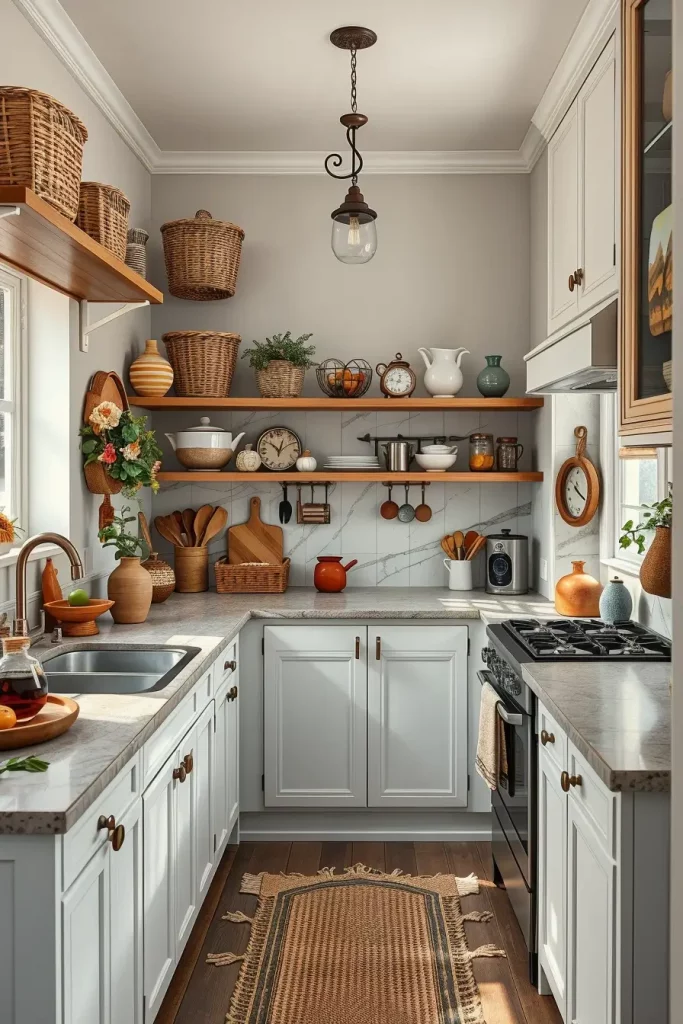
Each composition has to be selected well. Additional layers can be added to the room without overcrowding it with open shelving with woven baskets, thin marble backsplashes or a jute runner. The style and space are also maximized by using compact seating with natural upholstery.
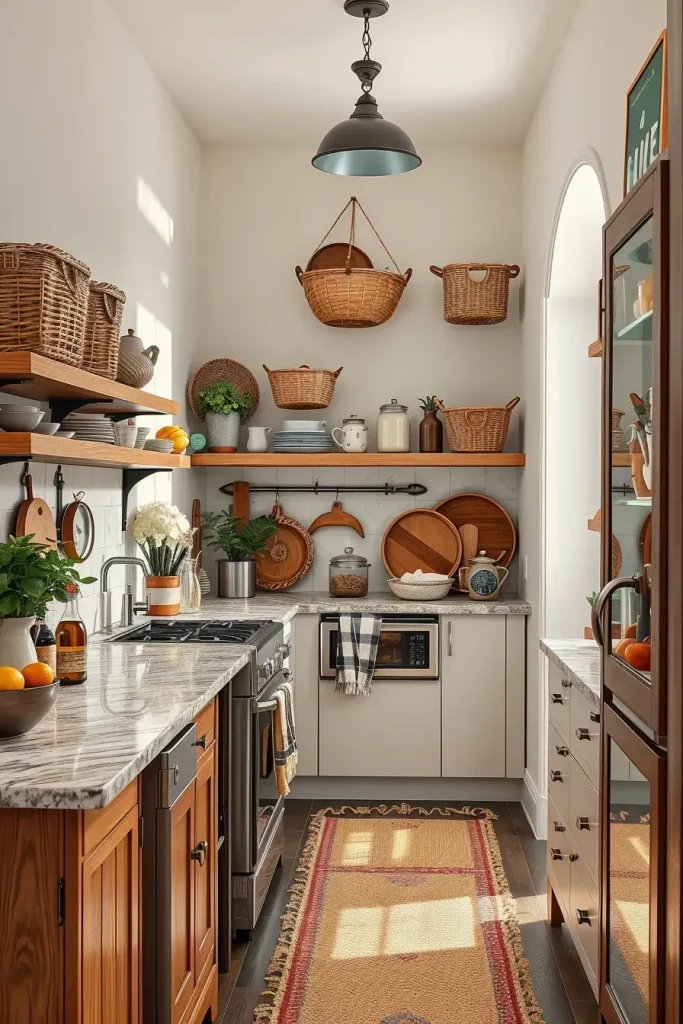
In my opinion, small kitchens are the best place to be creative. Apartment Therapy tends to emphasize the way textured materials can make small spaces appear curated instead of cramped, which I have also noticed in my own work.
To make the most of the limited space and to give the room an eclectic look, I would add a bit more details on the vertical storage, e.g. wall-mounted hooks or stacked shelves.
Luxury Eclectic Kitchens With Natural Details
Luxury does not imply the loss of the eclectic spirit–it is the refinement of the same by means of fine materials and workmanship. I prefer natural marble islands, custom made wooden cabinets and artisanal lighting to bring eclectic kitchens to the next level without losing their personality.
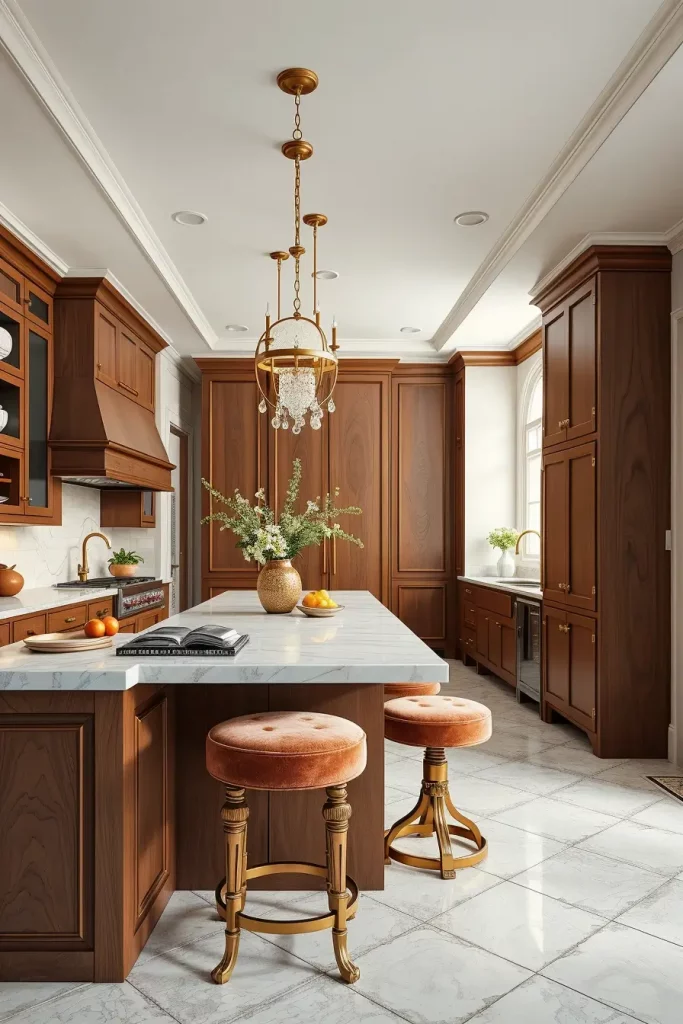
Each material adds prestige. Smooth stone and wood that is carved by hand is both graceful and down-to-earth. Bar stools may be covered with velvet upholstery and have brass decorations that do not dominate the natural foundation. The details matter when we are seeking luxury and natural textures.
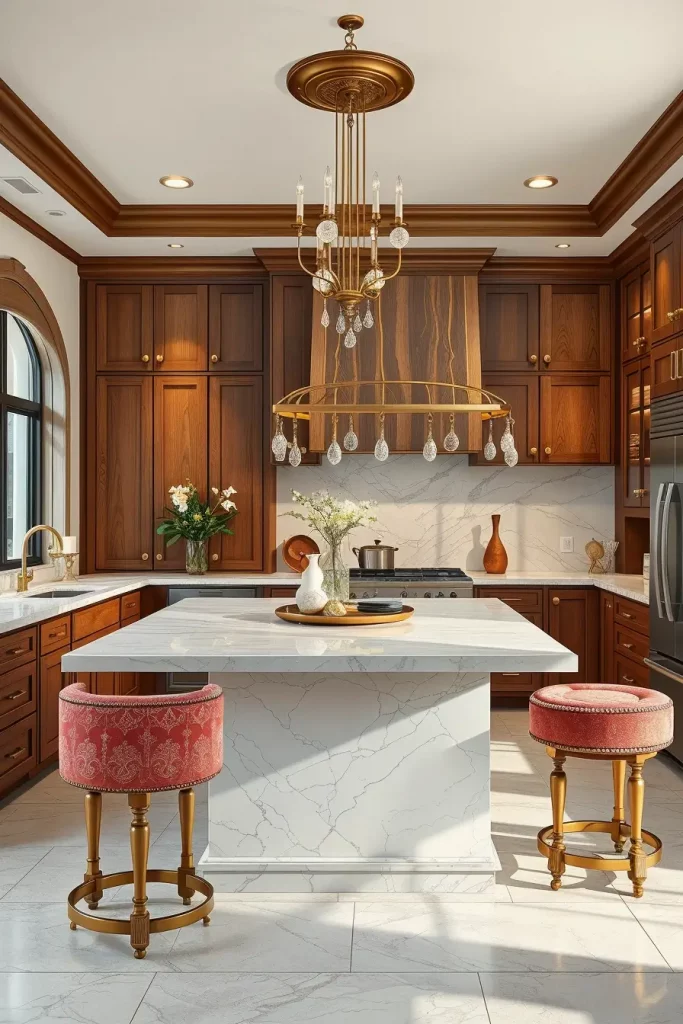
I personally believe that luxury eclectic kitchens are the best combination of comfort and elegance. House Beautiful has frequently lauded this style in its ability to combine both luxury and comfort and I feel that the trick is to use materials that are not only classic but also daring.
I would include a recommendation of low profile embedded technology like concealed appliances or intelligent lighting to introduce modern functionality to a high-end eclectic room without interfering with the design.
Affordable Eclectic Texture Solutions
I do not want to lose character or coziness when I consider a cost-effective design. Within a natural texture eclectic kitchen design, it is possible to find numerous ways to balance cost and character. I discover that reclaimed wood shelving, countertops that look like stone, created of laminate, and woven baskets are depth adding without breaking the budget. Combining textures does not imply increased spending–it implies creativity, which provides the kitchen with its own voice.
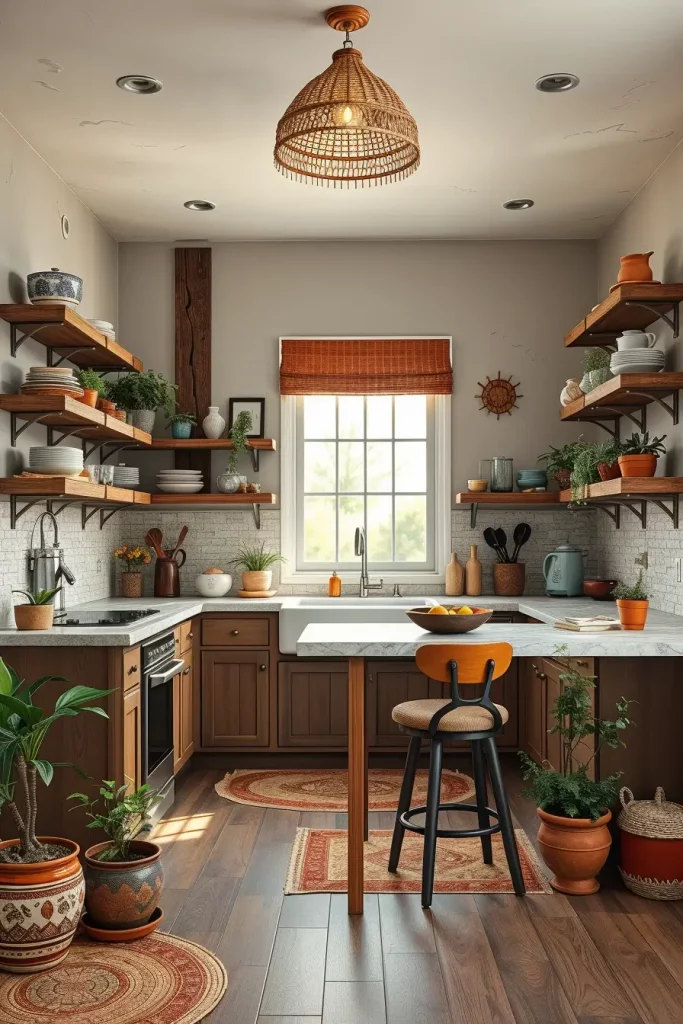
In the case of furniture and decor, I usually suggest open shelving with reclaimed wood, used bar stools, and ceramic dishes used as decorations. Natural fiber rugs can be used to make the floor softer and provide an additional layer of touch. These objects do not only add texture, but they also add soul to the room. I have found that a well-selected secondhand table with flaws can be much warmer than a new one.
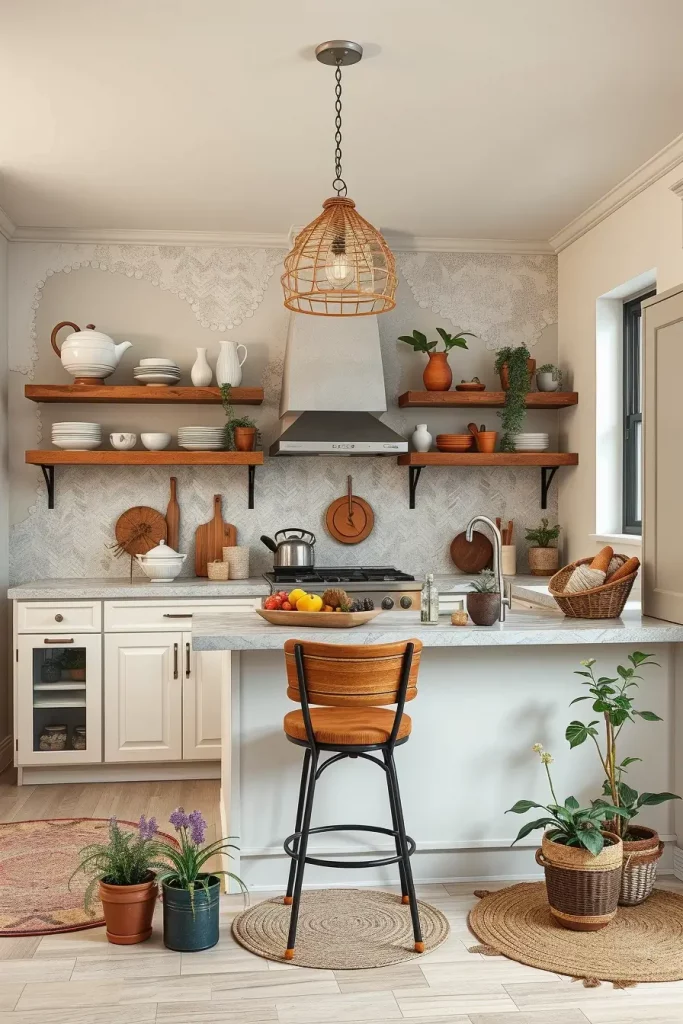
Personally, as a professional I have come to understand that when dealing with low-end eclectic kitchens, homeowners tend to underrate the role of lighting. The presence of a simple pendant with a rattan shade or a second-hand lamp with a warm bulb can immediately improve the mood. As Elle Decor notes, lighting layering is one of the cheapest methods of altering the overall atmosphere of a kitchen, but still maintaining the eclectic but homey effect.
I would also suggest the addition of natural items such as potted herbs or climbing plants in plain clay pots to complete this section. They are inexpensive, low-maintenance and instantly introduce textures into the kitchen and reinforce the natural feel.
Styling Tips For Eclectic Kitchens With Texture
I prefer to think in contrast and balance when I design an eclectic kitchen. An excess of natural textures may cause the room to be heavy and a deficiency may cause it to be cold. The trick is to combine stone, wood, ceramic and metal in such a way that it appears natural. Ex: a stone counter and a rough wooden island will provide a tactile balance that will make the room more interactive.
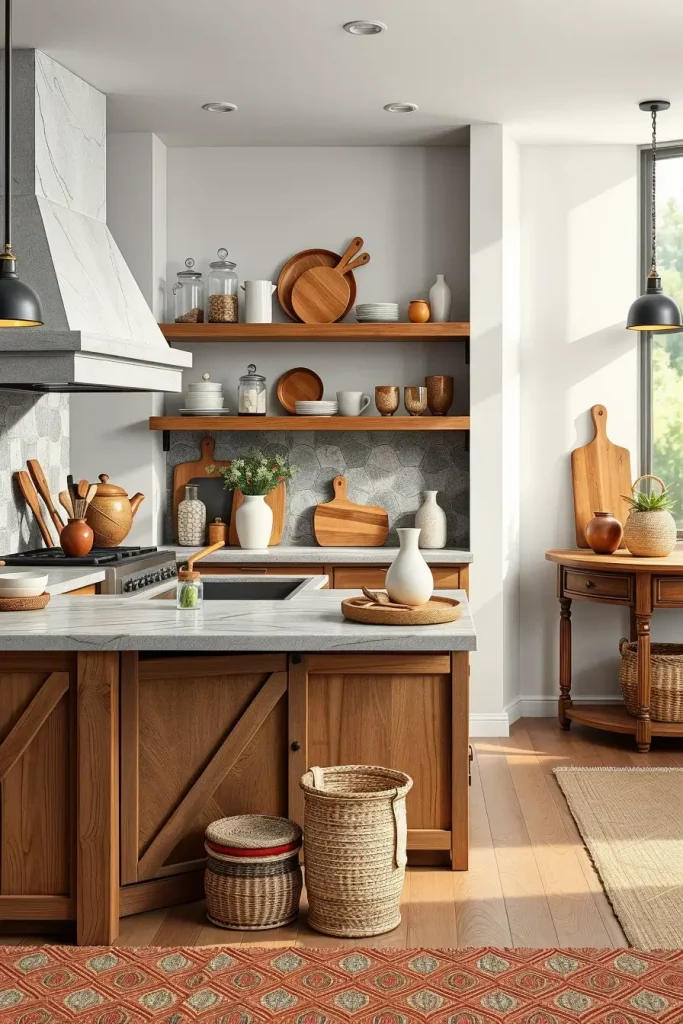
Regarding furniture and decor, I will suggest to combine the textures on various levels. Big wood cabinets may be combined with smaller objects such as woven rattan baskets or ceramic vases. Stone backsplash is a wonderful match to open shelving designed with glass jars and wooden cutting boards. Other layers, including a textured rug or a wall hanging, would be suggested, as well. It is this diversity that makes eclectic kitchens memorable.

My own experience has taught me that eclectic kitchens may employ a sense of restraint. Although I am tempted to use all the possible textures, I never forget the Architectural Digest rule: negative space. Allow surfaces of wood or stone to breathe without crowding them. This makes every texture more prominent and makes the design not look cluttered.
I believe what would improve this section is more of a focus on everyday functionality. The styling is not only a visual aspect of the kitchen activities but also a functional aspect with the use of textured trays, woven breadbaskets or even linen towels.
Conclusions about Eclectic Kitchens with Natural Textures
A natural textured eclectic kitchen design at the end of the day is about making the space alive and personal. Combining wood, stone, ceramics, and textiles we create a room that is both inviting, practical and fashionable. In my opinion, this design style is particularly effective with individuals who wish their kitchens to be an extension of their personality, yet remain connected to the beauty of the natural world.
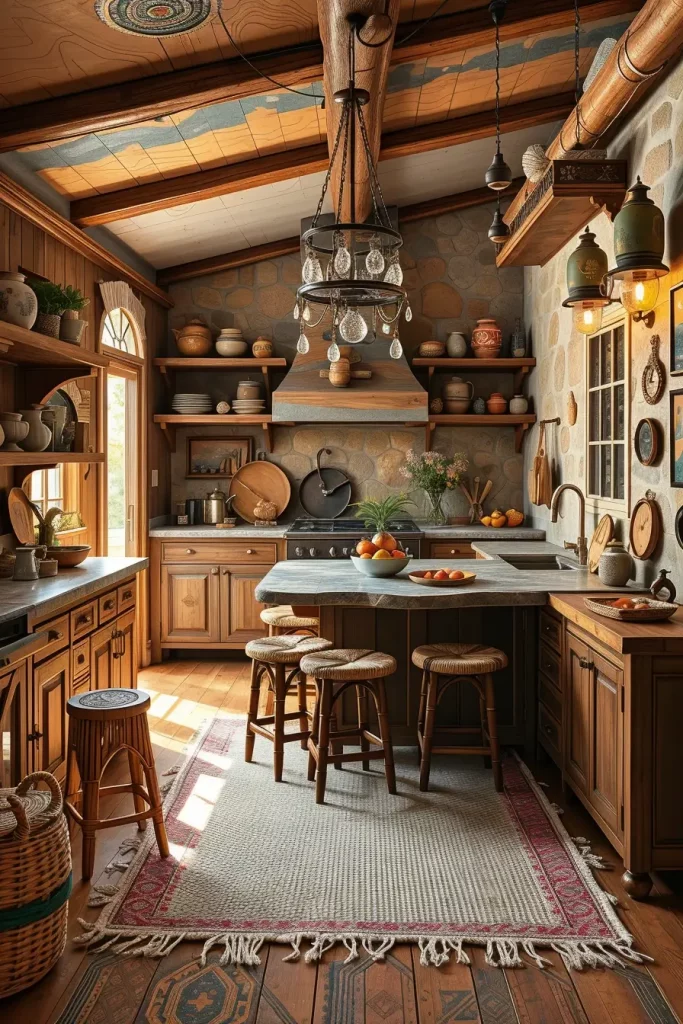
Furniture and accessories are also important as much as materials. The combination of reclaimed wood furniture, woven stools, stone countertops, and natural fiber rugs can change the whole mood of the kitchen. These are the kinds of textures that make us want to touch, use and enjoy the space, and this is what a kitchen is supposed to do.
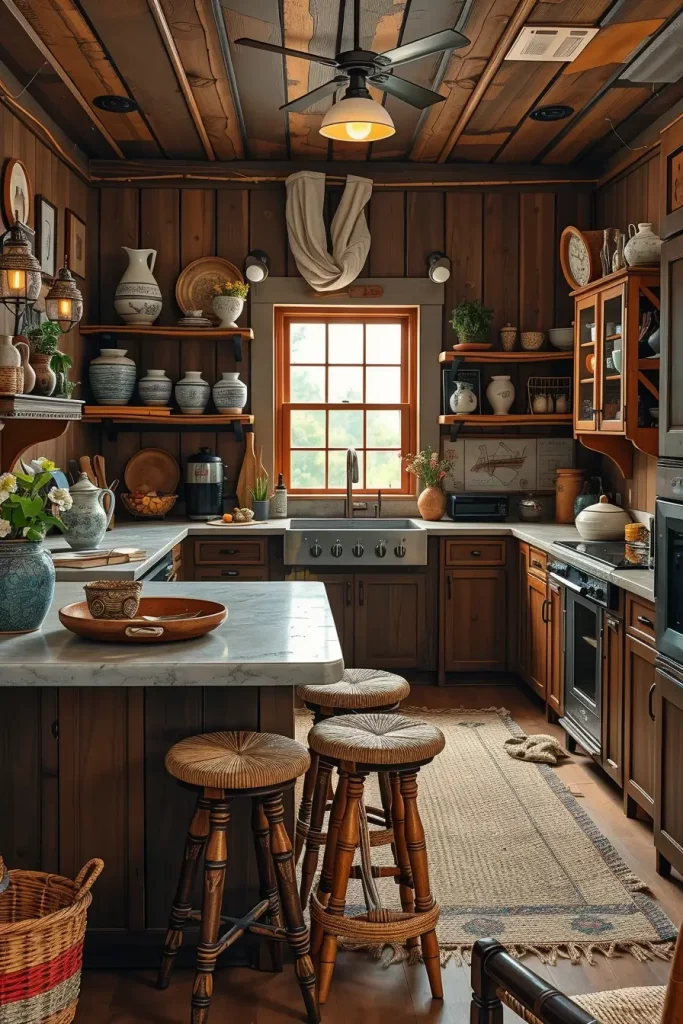
To my mind, eclectic kitchens are not about strict rules and more about a spirit of creativity. On the individual level, I have been able to see how natural objects and personal objects, such as family pottery or old trays can turn a kitchen into a place that feels inhabited and unique. House Beautiful claims that the most eclectic spaces always have a story and I could not agree more.
To complete the picture, I would also suggest the use of seasonal textures, such as a woven fruit bowl during the summer or a wool runner during the winter. These minor additions make the eclectic kitchen dynamic, but still based on natural elements.
Finally, an eclectic kitchen design with natural textures demonstrates that creativity and comfort are two things that can be combined in a wonderful way. Wood, stone, brick, marble, and metals combine to make a space that is personal and eternal. The materials narrate their stories but when combined they create a kitchen that is friendly, functional, and motivating.
How do you feel about eclectic design using natural textures? Post your thoughts or ideas in the comments–I would love to know how you would decorate your own kitchen!
